4 Strategies of Revenue Management
Competencies
- Understand the 4Ps in Marketing to control the Demand
- Identify strategies to move Supply and Demand
- Understand psychographic classification
Chapter 4 Outlines
5.1. Change the demand by the slope of the demand line
5.2. Change the demand by the equilibrium between demand and supply
5.3. Change the supply by the slope of the supply line
1. Change the demand by the slope of the demand line
A differentiation strategy aims to set a company apart from its competitors to enhance its appeal to customers and boost revenue. In the hospitality industry, such as hotels, differentiation involves creating distinctive features or qualities that make the hotel stand out. This approach not only attracts guests but also helps to justify premium pricing and build customer loyalty. There are four primary types of differentiation strategies that hotels often employ:
Uniqueness (Product planning): This strategy focuses on offering something that is not available anywhere else. It might involve unique architectural designs, exclusive amenities, or themed rooms that provide a distinctive experience. For instance, a hotel might feature a world-class art collection, a rooftop garden with panoramic views, or an innovative room layout that caters to specific guest interests.
Service Level: Differentiating through service level means providing a higher standard of customer service than competitors. This could include personalized guest experiences, exceptional attention to detail, or superior service quality. For example, a hotel might offer 24/7 concierge services, bespoke guest experiences tailored to individual preferences, or highly trained staff that exceed guests’ expectations.
Location (distribution): Leveraging location involves highlighting the benefits of the hotel’s geographical position. This could mean being situated in a prime tourist area, offering stunning natural surroundings, or being conveniently located near key business districts or transportation hubs. A hotel might emphasize its proximity to popular attractions, scenic views, or unique local experiences that enhance the overall stay.
Brand (promotion): Branding involves creating a strong, recognizable identity that resonates with guests and distinguishes the hotel from its competitors. This could include a consistent theme or image, a reputation for quality, or a specific market positioning. Effective branding can build trust and loyalty, with guests choosing a hotel based on its established reputation, unique brand promise, or the emotional connection they have with the brand.
By focusing on these areas of differentiation, hotels can attract a targeted audience, enhance guest satisfaction, and ultimately increase their revenue by offering something that competitors cannot easily replicate.
1.1. Differentiation strategy by uniqueness
Differentiation strategy by uniqueness involves crafting an experience that stands out distinctly from what competitors offer, making it particularly appealing to potential customers. This strategy focuses on creating and promoting attributes or features that are one-of-a-kind, ensuring that the hotel offers something that cannot be found elsewhere. Here’s how this approach can be effectively implemented:
Exclusive Offerings: (product planning) The hotel can provide exclusive experiences or services that are not available at other establishments. This could include unique amenities such as private dining experiences with renowned chefs, personalized wellness retreats, or custom-designed guest rooms that reflect a specific theme or cultural heritage.
Innovative Design: (attitude distribution) The physical and aesthetic aspects of the hotel can be designed to be distinctly different. For example, the hotel might feature a cutting-edge architectural style, artistic decor, or unique interior design elements that create a memorable visual and sensory experience. This could also involve incorporating local art, historical elements, or avant-garde design trends that set the hotel apart.
Signature Experiences: (attitude) Developing signature experiences that are exclusive to the hotel can attract guests seeking something special. This might include specialized tours, unique local excursions, or activities that are closely tied to the hotel’s location and brand. For instance, a hotel in a wine region might offer private vineyard tours and exclusive wine tastings that guests cannot access elsewhere.
Personalized Services: (service) Offering highly customized services tailored to individual preferences can also be a form of uniqueness. This might involve creating bespoke itineraries for guests, providing personal concierge services, or tailoring amenities to specific guest needs. For example, a hotel could offer a personalized welcome package based on guest preferences or provide custom room settings for different types of celebrations.
Innovative Technology: (instrumental, distribution) Integrating cutting-edge technology in a way that enhances the guest experience can also be a unique differentiator. This could include smart room features, virtual reality experiences, or advanced booking systems that streamline and personalize the guest journey.
Themed Accommodations: (instrumental theme) Designing rooms or suites around unique themes or concepts can also attract guests looking for something different. This could involve creating rooms inspired by different cultures, historical periods, or fictional worlds, offering a distinctive and immersive stay.
Cultural Integration: Embracing and integrating local culture in a unique way can provide a distinctive appeal. This might involve collaborating with local artisans for exclusive in-room decor, offering culinary experiences that highlight regional cuisine, or hosting cultural events that showcase local traditions.
By implementing these elements of uniqueness, a hotel can create a compelling value proposition that distinguishes it from competitors and resonates with potential customers. This strategy not only attracts guests seeking novel and memorable experiences but also helps build a strong brand identity centered around exceptional and unparalleled offerings.
Differentiation strategy by uniqueness focuses on enhancing the quality and appeal of a hotel by incorporating unique traits or features that distinguish it from competitors. This strategy involves creating memorable experiences that potential customers find particularly desirable and cannot easily find elsewhere. By offering something unique, a hotel can attract a niche market, build brand loyalty, and justify premium pricing.
A hotel can differentiate itself by incorporating distinctive traits or amenities that set it apart from other hotels, making it more appealing to specific segments of guests. This could involve various elements such as innovative design, exclusive services, or specialized amenities that enhance the guest experience and create a unique brand identity (Figure 57).
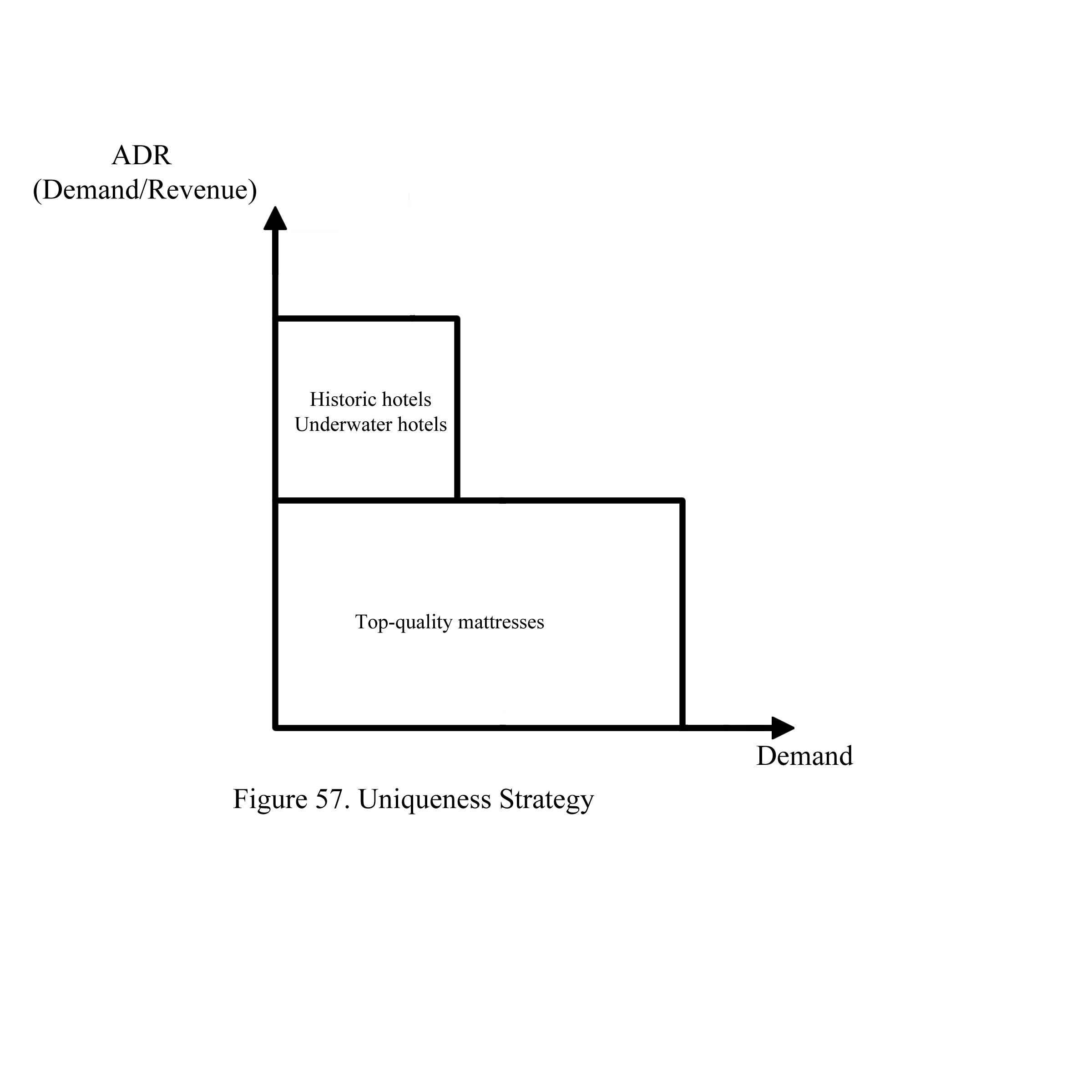
1.2. Differentiation Strategy by Service Level
Differentiation strategy by service level focuses on enhancing the quality of service provided to guests, which can significantly set a hotel apart from its competitors. This approach involves going beyond the standard service expectations to deliver an exceptional and memorable experience, often resulting in increased guest satisfaction, loyalty, and revenue. By investing in high-quality service, a hotel can attract discerning customers who are willing to pay a premium for superior experiences.
Increasing service quality is a key element of differentiating a hotel from its competitors. This strategy involves elevating the overall standard of service to exceed guest expectations, often through improved responsiveness, attention to detail, and specialized assistance. Higher service quality can lead to enhanced guest satisfaction, repeat business, and positive word-of-mouth, all of which contribute to increased revenue. For example, the hotel regularly conducts proactive maintenance and upgrades on all in-room technology to prevent issues before they arise. The hotel offers round-the-clock technical support services for guests. This includes a dedicated hotline or chat service where guests can report technical issues and receive immediate assistance.
Implementation: A 24/7 support team is available to address any technical difficulties at any time of the day or night, ensuring that guests receive timely help and solutions. The hotel provides personalized technical assistance tailored to individual guest preferences. By implementing a differentiation strategy focused on service level, such as hiring dedicated technicians to handle technical issues, a hotel can significantly enhance its reputation for quality and reliability. Guests are more likely to choose and return to a hotel that consistently provides exceptional service and resolves issues efficiently. This increased satisfaction often translates into higher revenue through repeat bookings, positive referrals, and the ability to command premium rates. Exceptional service not only improves the guest experience but also helps build a strong brand reputation, setting the hotel apart from competitors and fostering long-term success in the hospitality industry (Figure 58)
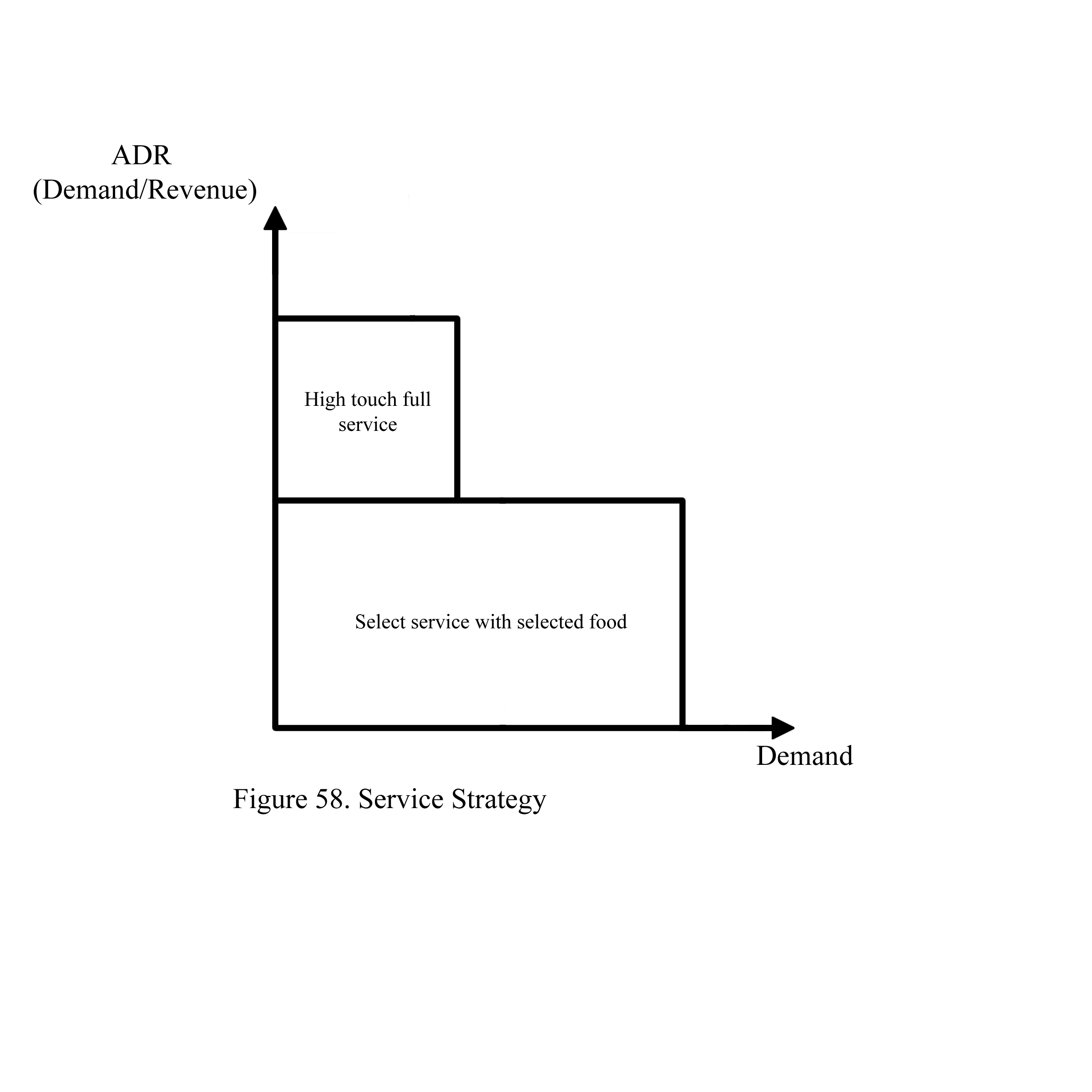
1.3. Differentiation Strategy by Location
Differentiation strategy by location involves leveraging the unique advantages of a hotel’s geographical position to distinguish it from competitors. This approach focuses on highlighting location-based benefits that appeal to guests and are not readily available from other hotels in the area. By emphasizing specific location advantages, hotels can attract guests who prioritize convenience, exclusivity, or unique experiences tied to the hotel’s surroundings. Setting your hotel apart through location involves capitalizing on the benefits that come with the hotel’s physical setting. This can include proximity to popular attractions, scenic views, cultural landmarks, or exclusive neighborhoods. By effectively marketing these location-based advantages, a hotel can attract a targeted audience looking for specific experiences or conveniences that only this location can offer. Hotel Near a Major Tourist Attraction. The hotel offers rooms with panoramic views of the Eiffel Tower, providing guests with a unique and memorable visual experience that other hotels further away cannot match. Local Cultural and Culinary Experiences. By integrating local experiences into its offerings, the hotel provides added value and enhances guests’ immersion in the local culture. The proximity to these experiences makes it more convenient for guests to enjoy them, setting the hotel apart from those located further away. Convenient Access to Transportation Hubs. For travelers prioritizing convenience and efficiency, the hotel’s location offers a significant advantage. The ease of getting to and from the hotel enhances the overall guest experience, particularly for those with tight travel schedules. Neighborhood Appeal. Guests seeking to experience the local culture and atmosphere are attracted to the hotel for its immersion in a desirable neighborhood. The hotel’s location becomes a key selling point, offering a more authentic and engaging stay.
By leveraging location as a differentiating factor, Landmark Suites enhances its appeal and sets itself apart from competitors. The hotel’s strategic position near a major tourist attraction provides a clear advantage, attracting guests who value convenience, exclusive experiences, and unique views. This differentiation not only helps the hotel stand out in a crowded market but also justifies premium pricing and fosters higher occupancy rates. Marketing the location effectively ensures that potential guests recognize the distinct benefits of staying at the hotel, leading to increased bookings, positive reviews, and enhanced brand reputation. The focus on location-based advantages can significantly contribute to the hotel’s overall success and competitive edge in the hospitality industry (Figure 59).
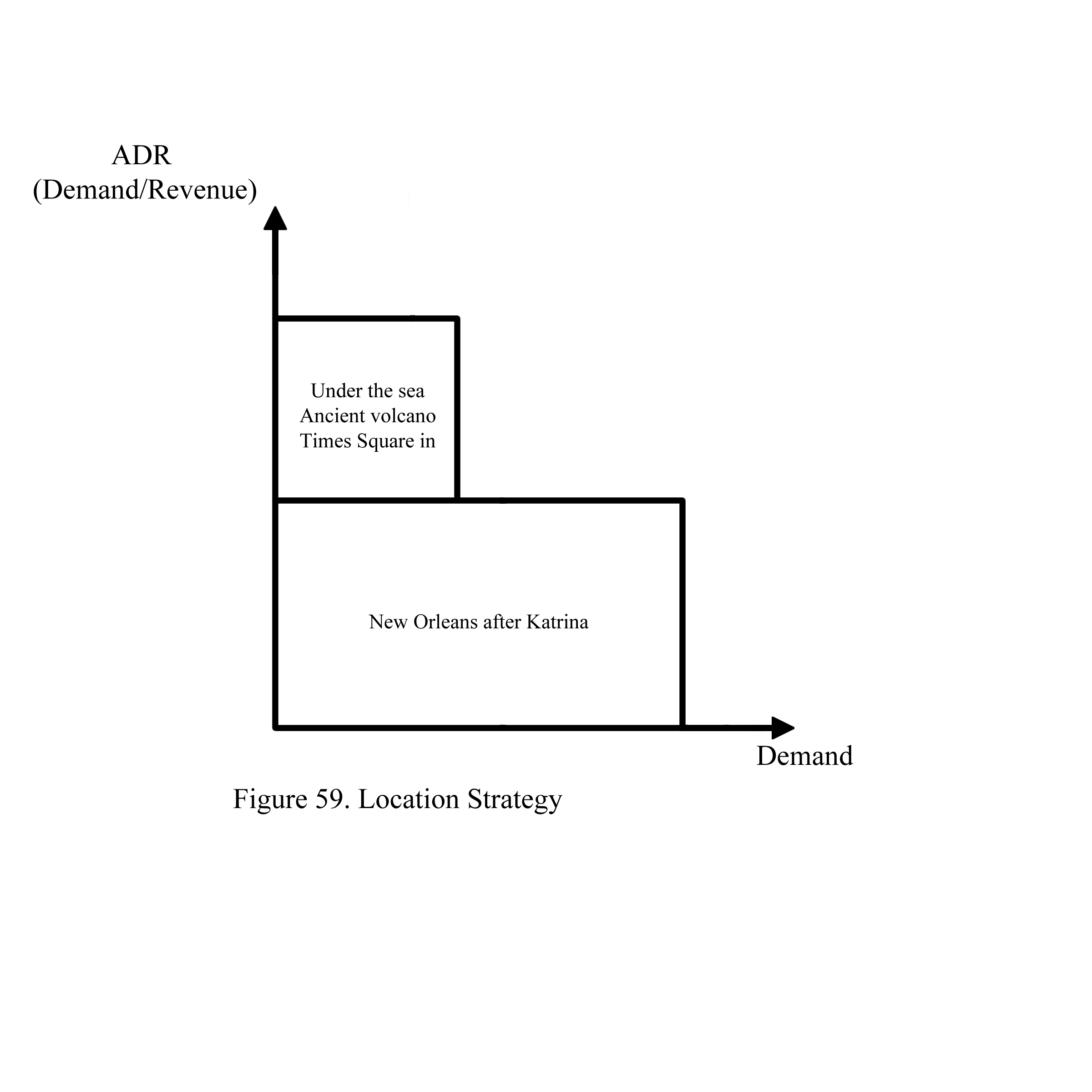
1.4. Differentiation strategy by brand
Differentiation by brand is a strategic approach where a business leverages the strengths and reputation of an established brand to create a competitive advantage. This strategy involves aligning with a well-known brand to attract customers by tapping into the distribution channels, brand loyalty, and customer familiarity that the established brand offers. The goal is to stand out in the marketplace not just by your own merits, but by associating with a brand that already holds a strong position in the minds of consumers.
For example, a small hotel like Motel 6 might partner with a luxury hotel brand like Sofitel, which is part of the Accor Group, a global hospitality company. Through this partnership, the smaller hotel can gain access to Accor’s vast distribution networks, marketing resources, and brand recognition. This alliance allows the smaller hotel to appeal to a broader audience, including those who are already loyal to Accor’s brands, and provides customers with a sense of familiarity and trust, even if they are booking with a smaller, lesser-known hotel.
This type of differentiation is particularly effective in industries where brand loyalty and recognition play a significant role in consumer decision-making. By associating with a larger, reputable brand, a smaller business can enhance its credibility, reach new customer segments, and potentially increase its market share, all while benefiting from the operational and marketing support of the larger partner (Figure 60).
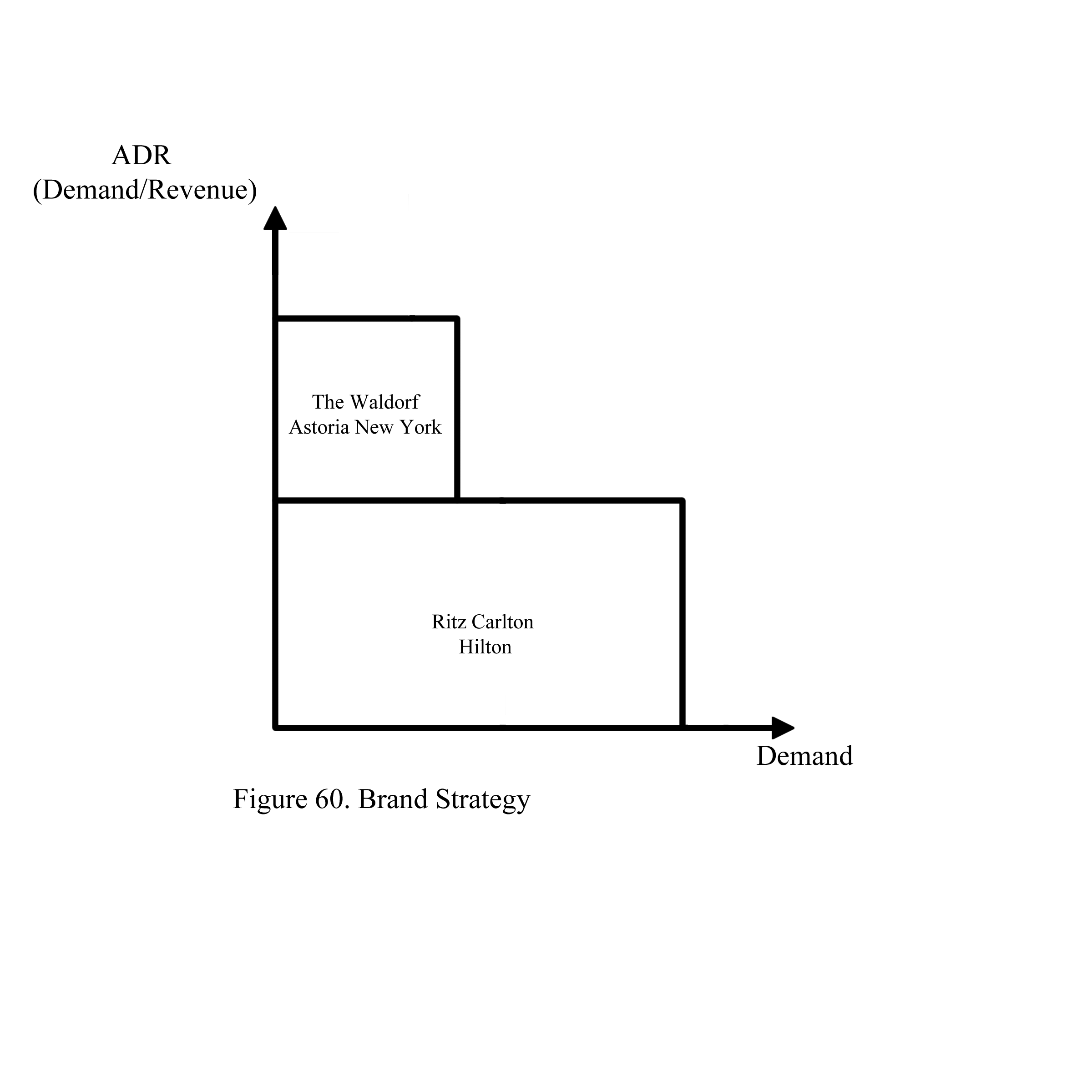
2. Change the equilibrium between demand and supply
The concept of equilibrium in marketing can be considered the “paradise” because it represents a state where supply meets demand perfectly, allowing businesses to maximize their profitability and efficiency. In this ideal state, resources are allocated optimally, and both consumers and producers are satisfied—customers get what they want at a price they are willing to pay, and sellers achieve their desired profit margins.
However, maintaining equilibrium in the market is challenging, as it is influenced by numerous factors such as changes in consumer preferences, economic conditions, and competition. When there is too much supply and too little demand, sellers are compelled to reduce prices to stimulate demand and clear excess inventory. Conversely, if demand outstrips supply, sellers can raise prices to balance the market and maximize profits.
For hoteliers, understanding and managing these fluctuations in equilibrium can lead to significant opportunities. If a hotel experiences high demand with limited supply, it can capitalize on this by increasing room rates, thereby enhancing profitability. On the other hand, during periods of low demand, strategic pricing adjustments and promotions can help maintain occupancy rates and revenue. (Figure 61).
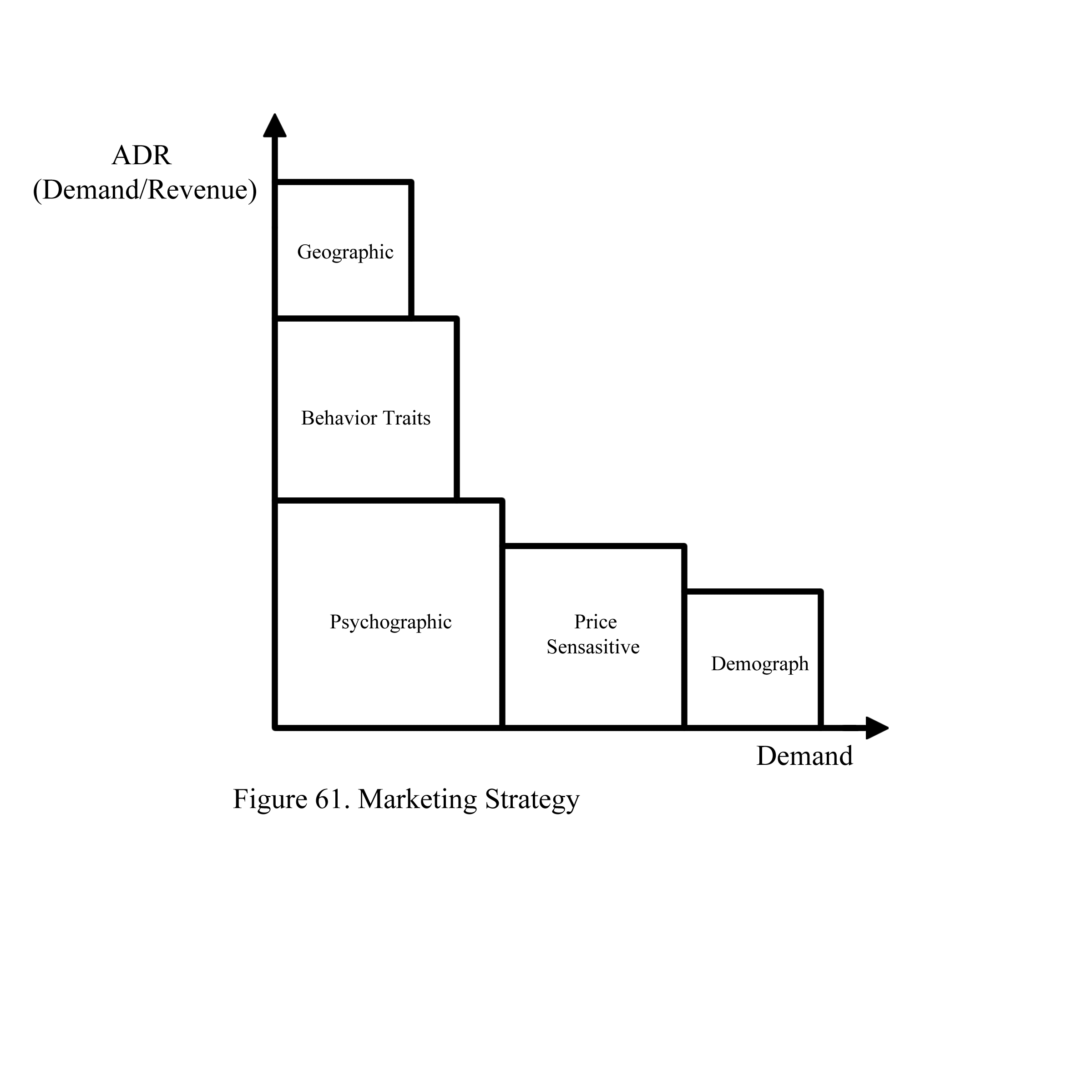
To navigate these market dynamics effectively, hoteliers can employ one or more of the five primary types of marketing strategies:
Geographic Strategy: This approach involves targeting customers based on their location. For instance, a hotel might focus on attracting local guests during off-peak seasons or appeal to international travelers by promoting proximity to tourist attractions.
Demographic Strategy: This strategy targets specific groups based on demographic factors such as age, gender, income level, and family status. For example, a luxury resort might market its services to high-income families, while a budget hotel might focus on young travelers or backpackers.
Psychographic Strategy: This strategy delves deeper into the psychological attributes of customers, such as their lifestyle, values, interests, and attitudes. A boutique hotel, for example, might appeal to eco-conscious travelers by highlighting its sustainability practices and green certifications.
Trait-Based Strategy: This approach targets customers based on specific traits or characteristics, such as loyalty, brand affinity, or travel habits. A hotel might offer exclusive perks to frequent travelers or personalize marketing messages based on a guest’s past stay preferences.
Price Sensitivity Strategy: This strategy focuses on understanding and responding to the price sensitivity of different customer segments. By identifying how much price influences purchasing decisions, hoteliers can tailor their pricing and promotions to attract price-sensitive customers during low-demand periods or premium customers during high-demand times.
By carefully analyzing market conditions and employing these strategies, hoteliers can better manage fluctuations in demand and supply, ensuring they remain competitive and profitable even as market equilibrium shifts.
2.1. Geographic strategy
A geographic strategy in marketing involves tailoring messages, promotions, and even the location of the business itself based on the geographical characteristics of the target audience. This strategy is particularly effective in the hospitality industry, where location plays a crucial role in attracting both guests and investors.
Geographic Strategy in Marketing
Geographic strategy in marketing is about sending targeted messages to potential guests based on their geographical location. This can include national, regional, or even neighborhood-level targeting. By understanding where potential guests are located, hotels can craft more relevant and personalized marketing campaigns that resonate with the specific needs and preferences of those in a particular area.
For example, a hotel in a popular tourist destination might focus its marketing efforts on travelers from regions or countries that frequently visit that area. Seasonal promotions might be designed to attract guests from colder climates to a sunny beach destination during the winter months. Additionally, marketing messages can be adjusted to reflect local customs, languages, and cultural preferences, making the communication more relatable and effective.
Geographic Strategy in Location Selection
Beyond marketing, geographic strategy also involves the careful selection of a hotel’s physical location. The choice of location is one of the most critical decisions in the hospitality industry, as it can significantly impact the hotel’s success in attracting both guests and investors.
Proximity to Attractions: A well-located hotel near popular tourist attractions, business districts, or transport hubs is more likely to attract a steady stream of guests. For instance, a hotel situated near a convention center can appeal to business travelers, while one near a beach or theme park can attract families and vacationers. (Figure 62)
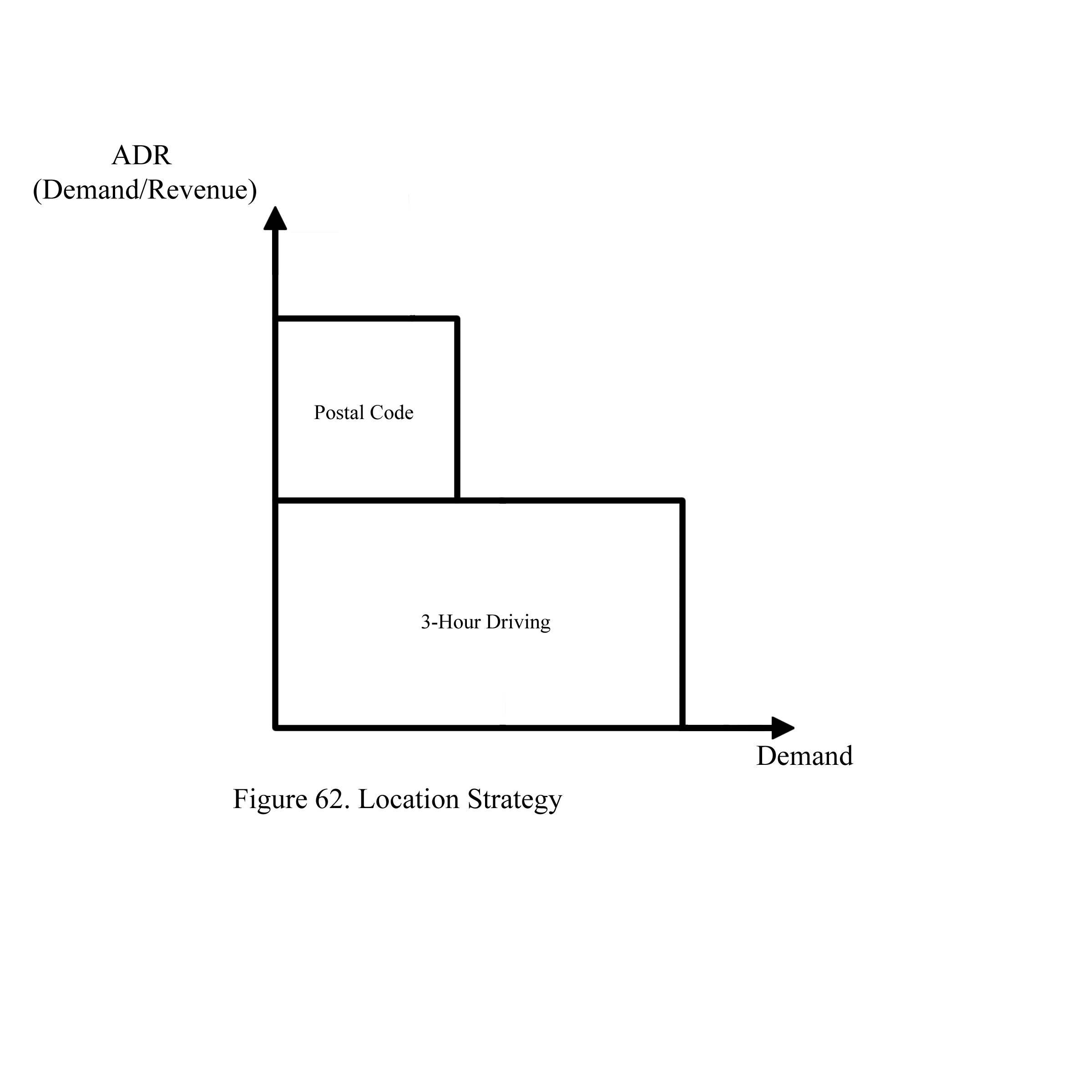
Market Demand: Choosing a location with high demand but limited competition can provide a significant advantage. By analyzing market data and trends, hoteliers can identify emerging destinations or underserved areas where a new hotel might thrive.
Accessibility: The ease of access to the hotel is another important factor. Locations near major highways, airports, or public transportation can make the hotel more appealing to both domestic and international travelers. Additionally, ensuring that the hotel is easy to find and reach can improve guest satisfaction and repeat business.
Local Economic Environment: The economic health of the surrounding area is crucial for attracting investors. A hotel located in a growing economy with a thriving tourism sector is more likely to secure investment. Investors are typically drawn to locations with a strong demand for accommodation, a stable economy, and potential for future growth.
Zoning and Regulations: Understanding local zoning laws and regulations is essential when selecting a hotel location. The chosen site must be suitable for hotel development and operation, and the legal environment should support the long-term viability of the hotel.
Cultural and Social Factors: A successful geographic strategy also considers the cultural and social environment of the location. For example, a hotel in a culturally rich area might offer services and amenities that reflect the local heritage, creating a unique and authentic experience for guests.
In summary, a geographic strategy encompasses both the targeted marketing efforts based on the location of potential guests and the strategic selection of a hotel’s physical location to attract both guests and investors. By leveraging the power of geography, hotels can position themselves more effectively in the market, ensuring they meet the needs of their target audience while maximizing their potential for profitability and growth
2.2. Marketing strategy by demographic
A demographic strategy in marketing involves segmenting potential customers based on various demographic factors such as age, gender, income, education, occupation, family status, and more. By understanding these demographic characteristics, businesses can create targeted marketing messages that resonate with specific groups, making their marketing efforts more effective. In the hospitality industry, this strategy is particularly valuable as it allows hotels to tailor their services and promotions to meet the distinct needs and preferences of different customer segments.
At its core, a demographic strategy in marketing is about delivering different messages to various customer groups based on their demographic profiles. By doing so, hotels can increase the relevance of their marketing campaigns, ensuring that the messages resonate more deeply with the intended audience.
Age: A luxury resort might target older, affluent couples with messages highlighting relaxation, fine dining, and wellness experiences, while a budget hotel might focus on younger travelers or backpackers, emphasizing affordability, adventure, and social activities.
Gender: A hotel might create specific marketing campaigns for women travelers, promoting safety, spa services, and female-only floors, while another campaign might target men, focusing on sports facilities, business services, or adventure packages.
Income Level: Luxury hotels may target high-income individuals with messages about exclusive experiences, personalized services, and high-end amenities, while mid-range hotels might focus on value for money, offering quality services at a reasonable price.
Beyond just segmenting customers based on basic demographic factors, a demographic strategy can also involve leveraging the social status of consumers to attract specific types of tourists. Social status refers to an individual’s standing or prestige in society, often influenced by factors such as wealth, education, occupation, and lifestyle. By understanding and appealing to the social status of potential customers, hotels can create a more aspirational brand image, attracting tourists who seek to enhance or maintain their social standing.
Luxury and Prestige: High-end hotels might position themselves as symbols of luxury and exclusivity, targeting affluent travelers who seek to project a certain image or status. Marketing messages could emphasize the exclusivity of the experience, the elite nature of the guest list, or the prestige of staying at a renowned property. These hotels often offer personalized services, luxury amenities, and unique experiences that appeal to those who value status and recognition.
Cultural and Social Aspirations: Hotels can also target consumers based on their cultural and social aspirations. For example, a hotel might market itself to well-educated, culturally curious tourists by emphasizing its proximity to historical landmarks, museums, or cultural events. By aligning with the interests and aspirations of this demographic, the hotel can attract guests who see value in enriching their social and cultural capital.
Family and Community-Oriented Stays: A hotel targeting middle-income families might highlight its family-friendly amenities, such as kids’ clubs, family suites, and affordable dining options. Marketing messages could focus on creating memorable family experiences, positioning the hotel as a place where families can come together and enjoy quality time.
Business and Professional Travelers: Hotels that cater to business travelers might leverage their demographic strategy by emphasizing their facilities for work, such as conference rooms, high-speed internet, and business centers. These messages would appeal to professionals who prioritize efficiency, convenience, and a conducive environment for business activities.
A demographic strategy is a powerful tool for hoteliers to connect with different customer segments by understanding and addressing their unique needs, preferences, and social status. By crafting targeted marketing messages that resonate with specific demographics, hotels can attract a diverse range of tourists, from affluent luxury seekers to culturally curious travelers, family vacationers, and business professionals. This approach not only enhances the effectiveness of marketing efforts but also helps in building a loyal customer base that feels understood and valued (Figure 63)
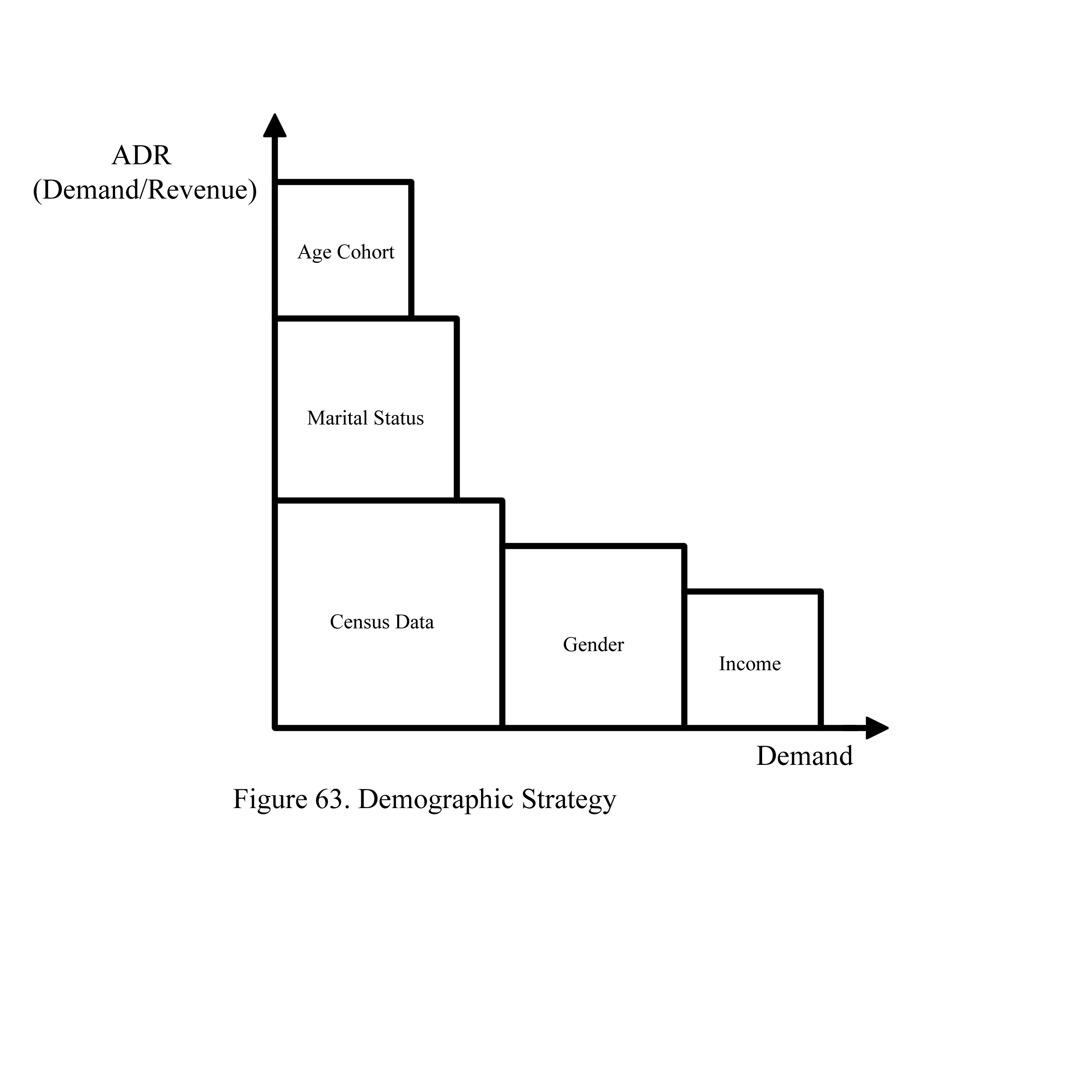
Demographic factors such as age, marital status, gender, and income play a significant role in shaping customer preferences and behavior. For instance, a young married couple might look for a high-end restaurant, while seniors or families with children checking into a hotel might be offered discounts. Additionally, guests with higher incomes may be provided with premium-quality rooms, but at a higher rate to boost the hotel’s revenue. Demographic factors, such as age, marital status, gender, and income, are crucial in understanding and catering to customer preferences and behaviors. These factors influence how customers perceive value, make purchasing decisions, and respond to different types of offers and services. Here’s a detailed look at how each demographic factor impacts hotel and restaurant strategies:
Age
Young Adults: Typically seek vibrant, trendy environments and may prioritize amenities like nightlife, modern decor, and active social scenes. Hotels and restaurants targeting this group might offer features such as live music, energetic atmospheres, and social events. For instance, a hotel catering to young adults might promote a rooftop bar or a nightclub within the property.
Middle-Aged Adults: Often prioritize comfort, quality, and convenience. This group might look for well-appointed rooms, business facilities, or family-friendly amenities. Restaurants may offer refined dining experiences or themed nights that appeal to this age group.
Seniors: Generally seek relaxation, comfort, and convenience. Hotels may offer features like accessible rooms, quiet environments, and easy transportation options. Senior guests might appreciate services such as early check-in, special dietary options, or senior discounts. Restaurants might offer early-bird specials, softer seating, and traditional or comfort foods (Figure 64)
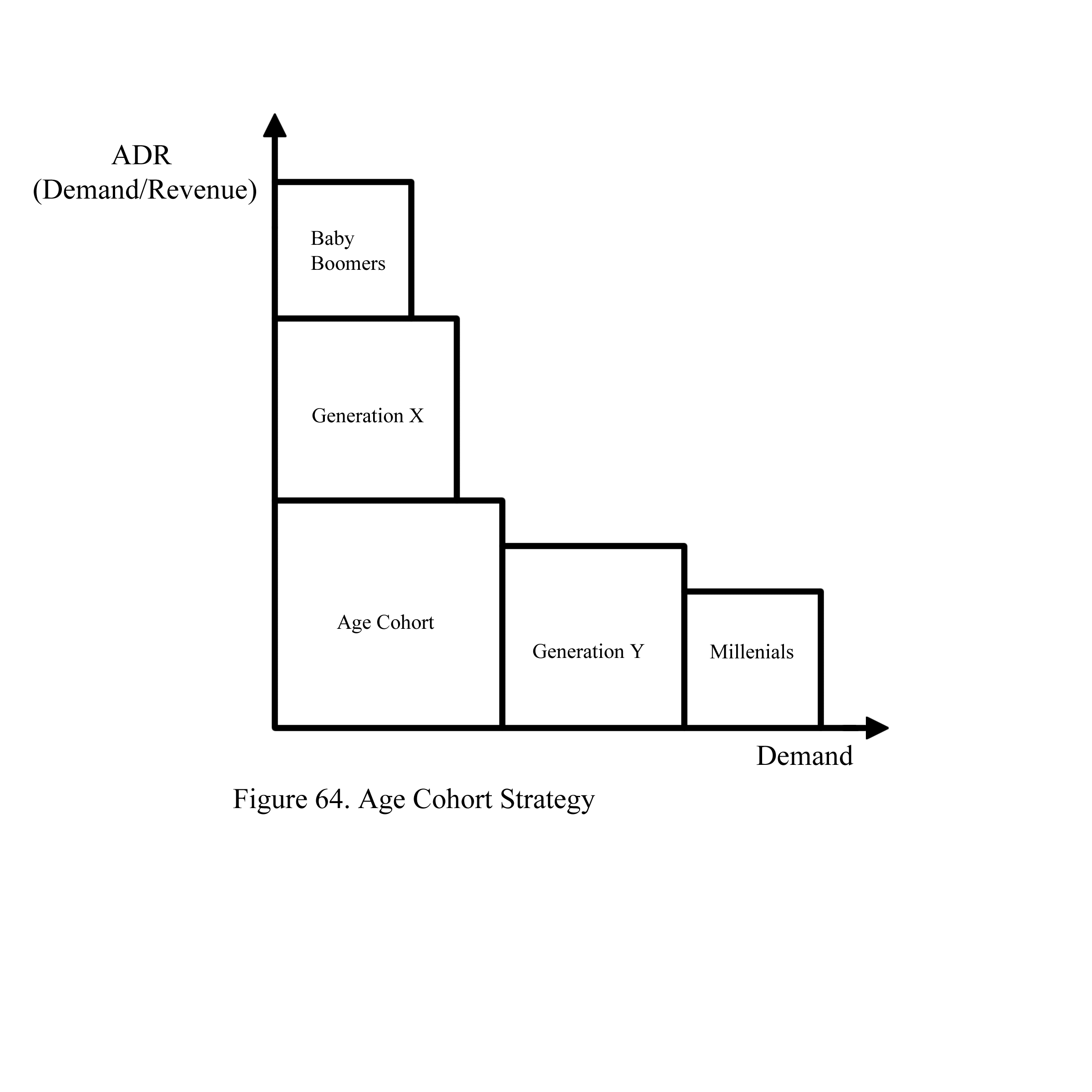
Marital Status
Singles: Often prefer hotels or restaurants with social opportunities and engaging experiences. They might be drawn to locations that offer lively atmospheres or unique events. For example, a hotel might offer singles mixers or social events as part of their stay.
Married Couples: May look for romantic getaways or family-friendly accommodations, depending on whether they have children. Hotels targeting couples might offer romantic packages, including dinner for two or couples’ massages, while family-friendly hotels might provide amenities like kid’s clubs or family suites.
Families: Generally seek accommodations that are safe, spacious, and equipped with family-oriented amenities. Hotels might offer larger rooms, babysitting services, or family packages that include tickets to local attractions. Restaurants might have children’s menus, high chairs, and family-friendly dining environments.
Gender
Men and Women: While both genders have diverse preferences, marketing strategies may include targeting specific interests or needs that are more prevalent among each gender. For example, hotels might market spa services more towards women or emphasize fitness facilities for men.
Gender-Specific Services: Some hotels and restaurants might offer gender-specific services, such as grooming or beauty amenities for women, or specialized sports and recreation facilities for men. However, it’s important to approach these offerings inclusively and consider the preferences of all guests (Figure 65)
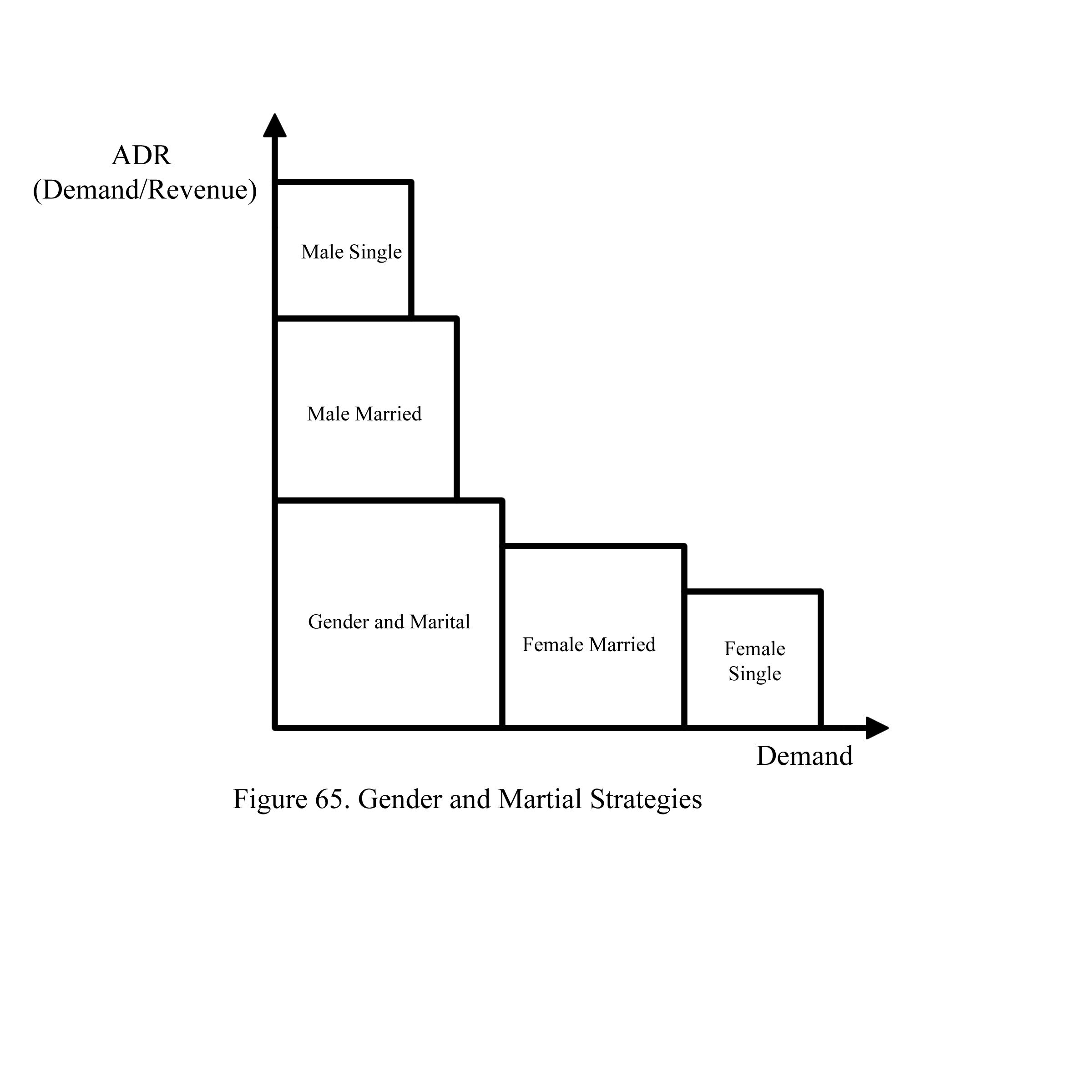
Income
High-Income Guests: Typically seek premium-quality accommodations and services, such as luxury rooms, high-end amenities, and exclusive experiences. Hotels might offer premium suites, concierge services, and fine dining options. Restaurants may provide gourmet menus, premium wine lists, and exceptional service. Pricing strategies for this segment might involve higher rates for upscale rooms or exclusive packages.
Middle-Income Guests: Look for good value for money. They appreciate a balance of quality and affordability. Hotels may offer mid-range rooms with essential amenities and provide promotions or packages that offer a perceived value. Restaurants might feature moderately priced menus with quality ingredients.
Low-Income Guests: Generally prioritize affordability and basic needs. Hotels may offer budget-friendly rooms with essential amenities, and restaurants might provide value-oriented menus or specials. Discounts and budget packages are crucial to attract this segment (Figure 66)
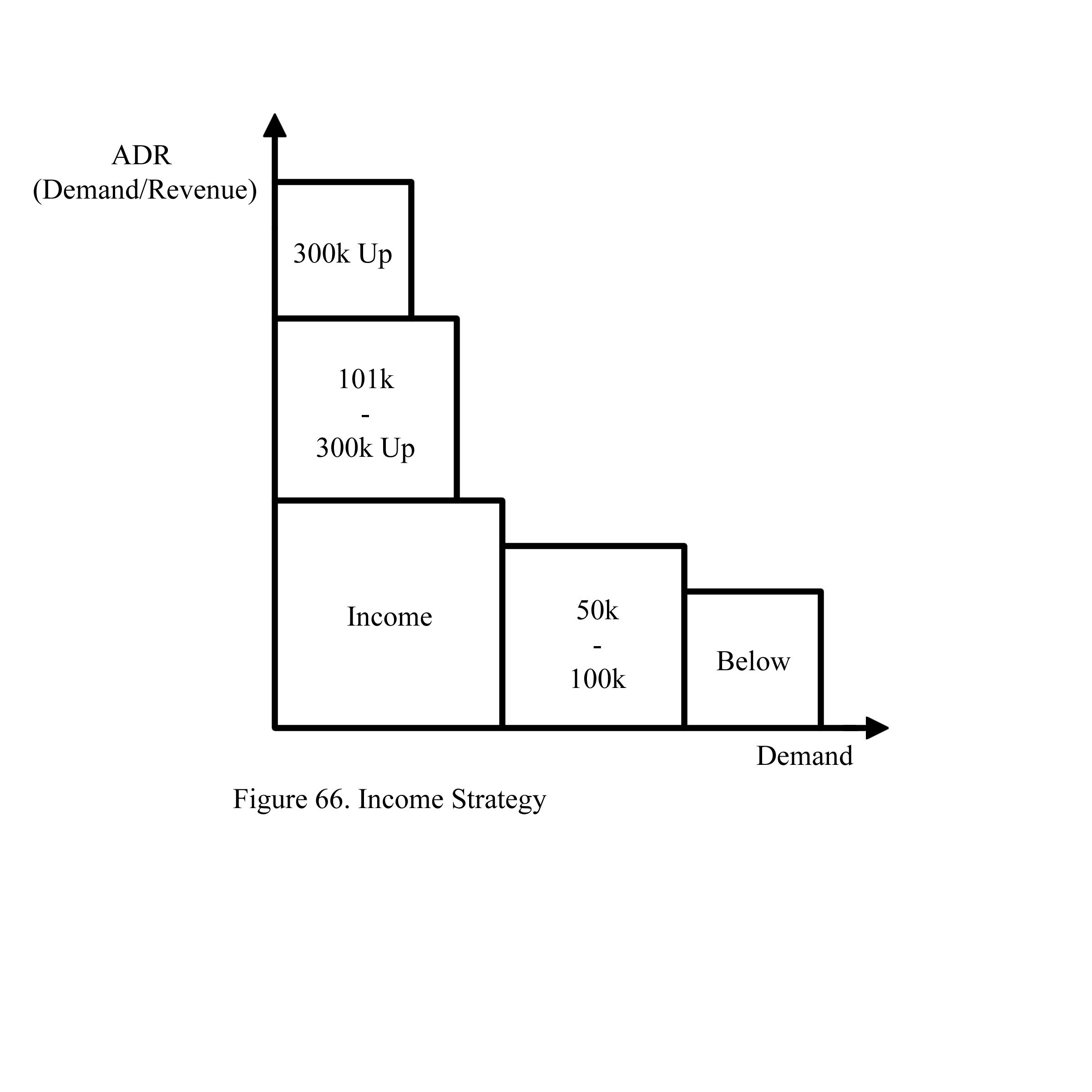
Examples of Demographic-Based Strategies
Hotel Marketing to Young Couples:
Room Packages: Offer romantic getaway packages that include a luxury suite, dinner for two, and spa treatments. Promote these packages through social media and dating apps where young couples are active.
Events: Host events like cocktail evenings or dance parties in the hotel’s lounge or rooftop area to attract young couples looking for social and romantic experiences.
Family-Friendly Hotel Offerings:
Amenities: Provide family suites with extra space, kitchenettes, and kid-friendly amenities such as a play area or kids’ club. Offer discounts or free stays for children.
Packages: Create family vacation packages that include tickets to local attractions, family dinners, and child-friendly activities. Promote these packages through family-oriented travel websites and parent blogs.
Senior Discounts and Services:
Discounts: Offer special rates or discounts for senior guests. Include benefits such as free breakfast or shuttle services to popular destinations.
Accessibility: Ensure that the hotel has accessible rooms, easy navigation, and services tailored to senior guests, such as assistance with luggage or mobility aids.
High-Income Guests:
Exclusive Experiences: Offer high-end experiences such as private dining, bespoke concierge services, or exclusive access to amenities. Market these experiences through luxury travel magazines and high-net-worth individuals’ networks.
Premium Rooms: Provide upscale rooms with luxury features like private balconies, high-end toiletries, and personalized service. Implement tiered pricing strategies to accommodate varying levels of luxury within the high-income segment.
Understanding and leveraging demographic factors is essential for developing effective marketing and operational strategies in the hospitality industry. By tailoring offerings to the specific needs and preferences of different age groups, marital statuses, genders, and income levels, hotels and restaurants can better meet guest expectations, enhance satisfaction, and ultimately drive revenue and loyalty. Implementing these strategies thoughtfully helps create a more personalized and appealing experience for each customer segment, contributing to the overall success and competitiveness of the business.
2.3. Marketing strategy by psycho graphic
A psycho graphic strategy in marketing involves tailoring products, services, and messaging based on the personal preferences, values, lifestyle, and psychological traits of the target audience. This approach goes beyond basic demographic factors like age or income, diving deeper into the motivations, attitudes, and behaviors that drive customer decision-making. By understanding the unique psycho graphic profiles of their customers, businesses can create more personalized and relevant experiences that resonate on an emotional level, leading to stronger brand loyalty and higher customer satisfaction.
In addition to focusing on personal preferences, a psycho graphic strategy also considers the core qualities that an average customer seeks in a product or service—specifically, cost, quality, and affluence. These three factors often play a pivotal role in shaping purchasing decisions, and understanding how they influence customer behavior can help businesses design offerings that align with their customers’ psycho graphic profiles.
Cost: For many customers, cost is a critical factor in their decision-making process. A psycho graphic strategy might involve identifying customers who are particularly price-sensitive and tailoring offers to meet their needs. For example, a hotel might develop a reputation for providing exceptional value by offering high-quality services at competitive prices, appealing to budget-conscious travelers who still desire a comfortable and enjoyable experience.
Quality: Quality is another key consideration for many customers, particularly those who prioritize the overall experience and the value they receive for their money. A psycho graphic strategy could involve enhancing the quality of services or amenities to attract customers who are willing to pay a premium for superior experiences. This approach might involve upgrading room features, improving customer service, or offering exclusive amenities that appeal to customers who place a high value on quality.
Affluence: Affluence reflects a customer’s willingness and ability to spend on luxury or premium experiences. A psycho graphic strategy might target affluent customers by offering exclusive, high-end services that cater to their desire for luxury and status. For instance, a hotel could offer personalized concierge services, private dining experiences, or bespoke travel packages designed to appeal to wealthy guests who seek unique and prestigious experiences.
Consider a hotelier who aims to enhance their reputation among different customer segments by strategically balancing cost and quality. To attract the “cost-plus” segment—customers who are willing to pay slightly more for better quality—the hotel might lower prices on certain services while simultaneously upgrading the quality of its offerings. This could involve renovating rooms to provide more comfort, offering complimentary high-speed internet, or including free breakfast as part of the stay. By doing so, the hotel not only appeals to price-sensitive customers but also enhances its reputation for providing excellent value.
For the “no-frills” segment—customers who prioritize low cost above all else—the hotel might focus on offering clean, comfortable, and basic accommodations at the most competitive price. By maintaining a strong focus on affordability while ensuring a good level of quality, the hotel can attract a steady stream of budget-conscious travelers who appreciate value for money.
In both cases, the hotelier leverages a psycho graphic strategy to align with the psychological needs and preferences of their target customers, whether they prioritize cost, quality, or a combination of both. By understanding and catering to these underlying motivations, the hotel can create a more appealing and competitive offering, ultimately leading to increased customer satisfaction and loyalty.
A psycho graphic strategy is a powerful tool for businesses to connect with their customers on a deeper level by addressing their personal preferences, values, and psychological needs. By focusing on key qualities such as cost, quality, and affluence, and understanding how these factors influence customer behavior, businesses can design tailored products and messages that resonate with their target audience. This approach not only enhances customer satisfaction but also helps build a strong brand reputation and fosters long-term loyalty (Figure 67)
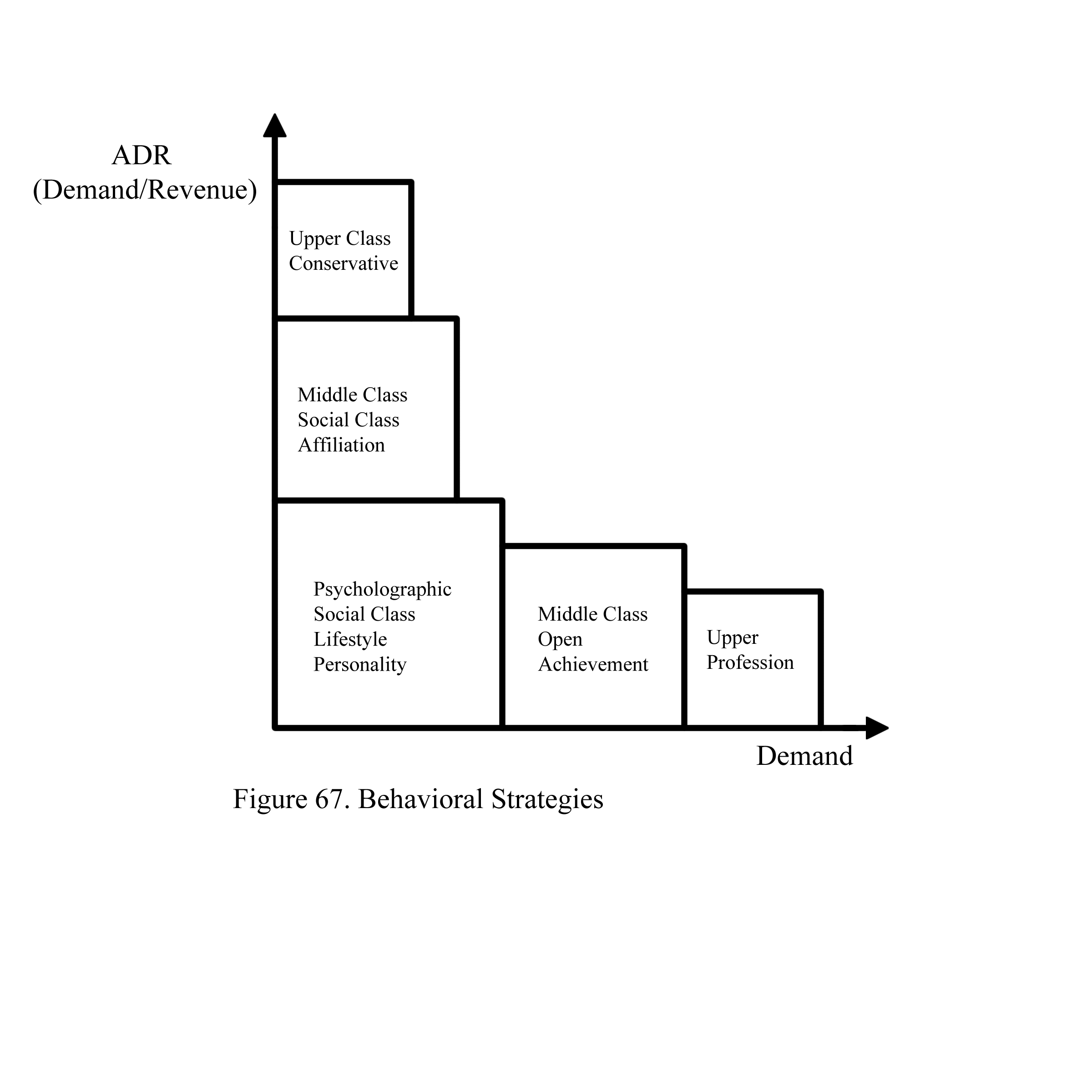
2.4. Marketing strategy by behavioral traits
A behavioral trait strategy in marketing is an approach that tailors products, services, and experiences based on the psychological traits and behaviors of customers. This strategy delves into the deeper, more intrinsic aspects of customer behavior, often focusing on well-established personality models like the Big Five traits—Conscientiousness, Openness, Agreeableness, Extraversion, and Neuroticism. By understanding these traits, hoteliers can create more personalized and emotionally resonant experiences that cater to the specific needs and preferences of their guests.
Behavioral Trait Strategy: The Big Five Personality Traits
The Big Five personality traits are widely recognized in psychology as key dimensions that describe human personality. Each trait reflects a spectrum of behaviors, emotions, and attitudes, and by aligning their offerings with these traits, hoteliers can better meet the psychological needs of their guests.
Conscientiousness: Individuals high in conscientiousness are typically organized, responsible, and detail-oriented. A hotel targeting this trait might focus on providing exceptional service, immaculate rooms, and meticulous attention to detail. For example, such a hotel might offer personalized wake-up calls, highly structured itineraries, and carefully curated in-room amenities that appeal to guests who value order and precision.
Openness: Guests high in openness tend to be curious, imaginative, and open to new experiences. A hotel catering to this trait might offer unique and culturally rich experiences, such as themed rooms, art installations, or workshops on local crafts and traditions. These guests might appreciate a hotel that encourages exploration and offers opportunities to engage with the local culture or participate in creative activities.
Agreeableness: Guests with high agreeableness are often cooperative, compassionate, and value positive social interactions. A hotel might appeal to this trait by emphasizing warm, friendly service, community-oriented events, and family-friendly amenities. Special attention could be given to creating a welcoming atmosphere, with staff trained to provide empathetic and personalized service that fosters a sense of belonging and community.
Extraversion: Extraverted individuals are sociable, energetic, and enjoy being around others. To cater to this trait, a hotel might offer lively social spaces such as bars, lounges, and communal areas where guests can interact. Activities like group excursions, social events, and nightlife options would also be appealing to these guests, who thrive in environments that allow for social interaction and stimulation.
Neuroticism: Guests with higher levels of neuroticism may be more prone to stress, anxiety, or emotional sensitivity. A hotel targeting this trait might focus on creating a calming and soothing environment. For instance, the hotel could offer rooms designed for relaxation, with features like soundproofing, soft lighting, and calming scents. Additional services might include stress-relief amenities such as spa treatments, meditation sessions, or tranquil garden areas. The hotel might also consider reducing costs for these rooms to make them more accessible, ensuring that guests feel comfortable and cared for during their stay.
Consider a hotel that identifies a segment of its guests as having higher levels of neuroticism. To enhance their experience, the hotel might offer rooms specifically designed to reduce stress and promote relaxation. These rooms could feature elements like soothing color schemes, aromatherapy diffusers with calming scents, and sound machines that play relaxing nature sounds. The hotel might also include complimentary access to wellness facilities such as a spa or yoga classes.
To further appeal to this guest segment, the hotel could offer these rooms at a slightly reduced rate, recognizing that the value of a stress-free environment may be particularly important to these guests. This thoughtful approach not only addresses the psychological needs of the guests but also demonstrates the hotel’s commitment to providing a personalized and empathetic experience.
A behavioral trait strategy is a sophisticated approach that allows hoteliers to connect with their guests on a deeper psychological level by catering to their specific personality traits. By focusing on the Big Five personality traits—Conscientiousness, Openness, Agreeableness, Extraversion, and Neuroticism—hoteliers can create tailored experiences that resonate with the unique behaviors and preferences of each guest segment. This strategy not only enhances guest satisfaction but also fosters loyalty, as guests are more likely to return to a hotel that understands and meets their individual needs (Figure 68).
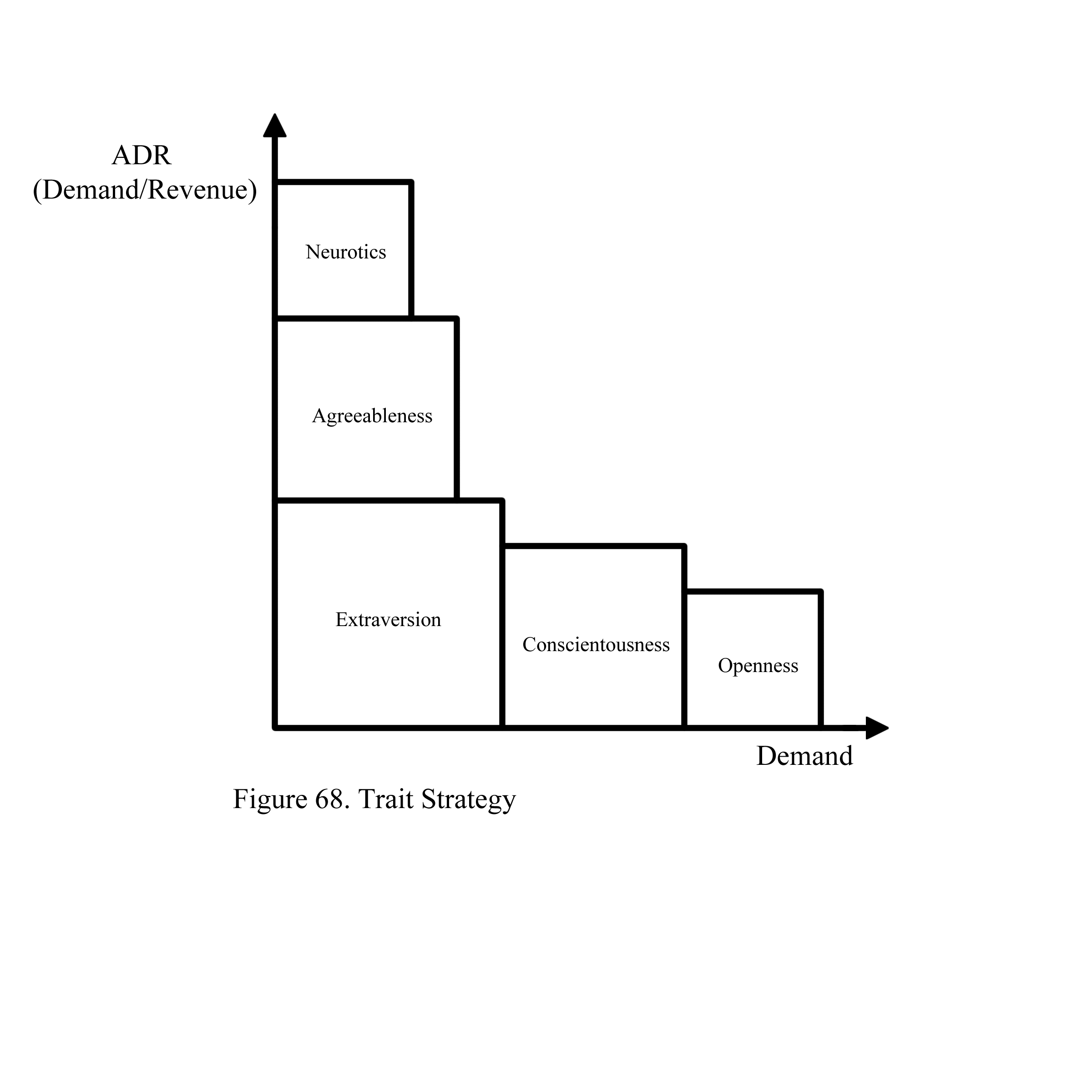
2.5. Marketing strategy by price-sensitivity
A price sensitivity strategy involves customizing marketing messages, offers, and pricing structures to appeal to different groups of potential customers based on how sensitive they are to changes in price. This strategy recognizes that not all customers react the same way to price fluctuations—some are highly sensitive and will change their buying behavior with even small price adjustments (price-elastic customers), while others are less affected by price changes and are more focused on other factors like quality, brand loyalty, or convenience (price-inelastic customers).
Price sensitivity as a strategy doesn’t just focus on pricing alone but rather integrates elements of geographic, demographic, psychographic, and behavioral trait strategies to create a comprehensive approach. By understanding the complex interplay of these factors, hoteliers can design pricing and promotional strategies that cater to a wide range of customer segments, each with varying levels of price sensitivity.
Tailoring Offers for Price-Elastic Customers: Customers who are price-elastic are highly responsive to price changes. For these individuals, even a slight decrease in price can significantly influence their decision to choose one hotel over another. To attract these customers, a hotel might employ tactics such as discounts, promotions, or value-added packages that emphasize affordability. Marketing messages could highlight deals, seasonal promotions, or loyalty programs that provide immediate financial benefits. This approach is particularly effective during off-peak seasons or in highly competitive markets where customers are more likely to shop around for the best deal.
Catering to Price-Inelastic Customers: Price-inelastic customers, on the other hand, are less concerned with price and more focused on the overall value, quality, or unique experiences a hotel can offer. For these guests, a hotel might emphasize premium services, exclusive amenities, and personalized experiences that justify a higher price point. Marketing strategies could focus on the unique aspects of the hotel, such as luxury accommodations, bespoke dining experiences, or unparalleled customer service. These customers are often willing to pay more for a superior experience, and the hotel can capitalize on this by maintaining higher price points while offering exceptional value.
Segmented Pricing: A key aspect of a price sensitivity strategy is the ability to segment the market based on different levels of price sensitivity. By understanding the demographic, psychographic, and behavioral traits of their customers, hotels can create tiered pricing structures that cater to different segments. For example, a hotel might offer standard rooms at a competitive rate for price-sensitive travelers, while offering premium suites at a higher rate for those seeking luxury. Additionally, dynamic pricing models can be employed, where prices fluctuate based on demand, ensuring that the hotel maximizes revenue while still appealing to a broad audience.
Geographic Considerations: Geographic factors also play a role in price sensitivity. Customers from different regions or countries may have varying perceptions of value based on their economic backgrounds and local cost of living. A hotel might adjust its pricing and promotions based on the geographic location of its target customers, offering different rates or packages to domestic versus international travelers. For example, a hotel in a tourist-heavy area might offer special discounts to attract local residents during off-peak times or create packages that include transportation for international guests.
Psychographic Influences: Psychographic factors, such as a customer’s values, lifestyle, and spending habits, also influence their price sensitivity. For instance, a hotel might target eco-conscious travelers who are willing to pay a premium for sustainable accommodations. By emphasizing the environmental benefits of their stay, the hotel can appeal to customers who prioritize sustainability over cost. Conversely, for customers who value budget-friendly travel but still want quality, the hotel might offer simple, yet comfortable rooms at an attractive price point.
Imagine a hotel that has identified two primary customer segments: budget-conscious travelers who are highly price-sensitive and affluent guests who prioritize quality and exclusivity over cost. For the price-sensitive segment, the hotel might offer a “budget-friendly” package that includes basic accommodations, complimentary breakfast, and discounts on local attractions. This package would be promoted heavily during off-peak seasons to attract cost-conscious guests looking for a good deal.
For the more affluent, price-inelastic guests, the hotel could offer a “luxury escape” package that includes a stay in a premium suite, personalized concierge services, gourmet dining experiences, and exclusive access to spa facilities. This package would be marketed as an all-inclusive luxury experience, appealing to guests who are willing to pay more for added value and comfort.
By simultaneously offering different pricing strategies tailored to each segment, the hotel maximizes its appeal across a diverse customer base, ensuring that it meets the needs of both price-sensitive and price-inelastic customers.
A price sensitivity strategy is a comprehensive approach that integrates various elements of customer segmentation, including geographic, demographic, psychographic, and behavioral factors, to create targeted pricing and marketing strategies. By understanding and addressing the different levels of price sensitivity among their customers, hoteliers can effectively attract and retain a diverse range of guests, from those who prioritize affordability to those who seek premium experiences. This approach not only enhances customer satisfaction but also optimizes revenue by aligning pricing with the specific needs and preferences of each customer segment (Figure 69).
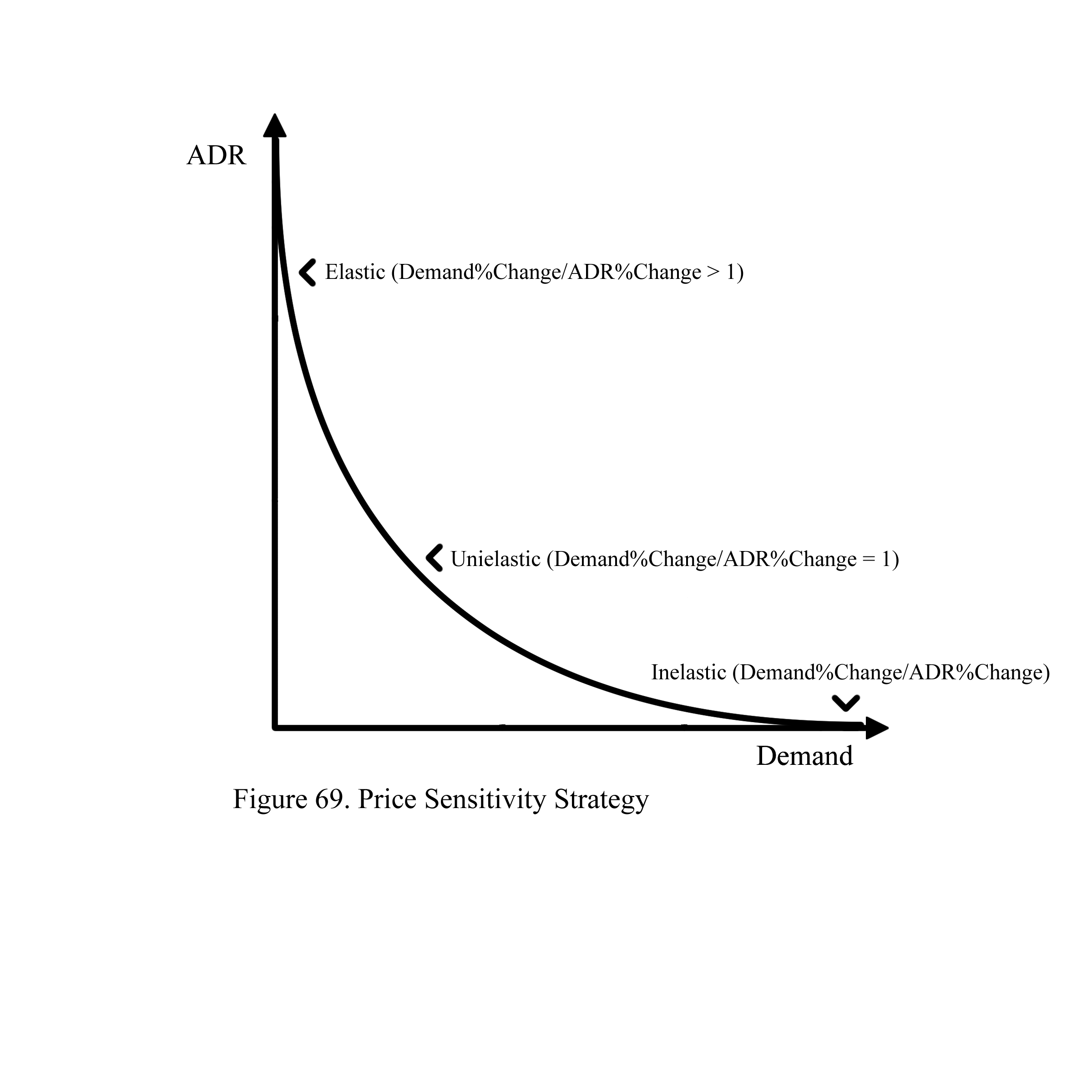
3. Change the supply
Changing supply through marketing strategy involves adjusting the availability of rooms, services, or experiences in response to market demand, while simultaneously using marketing efforts to influence and manage that demand. This approach is particularly relevant in the hospitality industry, where hotels must balance their room inventory and services with fluctuating levels of customer demand throughout the year.
In the hotel industry, supply refers to the number of rooms available, the types of accommodations offered, and the range of services provided to guests. By strategically managing this supply, hotels can optimize occupancy rates, maximize revenue, and better meet customer expectations. Changing supply through marketing involves both the physical adjustment of what is offered and the way these adjustments are communicated and promoted to potential guests.
Imagine a hotel located in a popular beach destination that experiences a significant increase in tourist arrivals during the summer months but sees a decline in visitors during the off-peak season. To maintain profitability and optimize room occupancy year-round, the hotel could implement a marketing strategy that adjusts its supply based on seasonal demand.
Peak Season Strategy:
Expanding Supply: During the summer, when demand is high, the hotel might increase its supply by offering additional rooms or expanding its services. For example, the hotel could temporarily convert unused conference rooms into guest accommodations or add more beachside cabanas to meet the increased demand for premium experiences.
Marketing Focus: The marketing strategy during this period would emphasize the availability of these additional rooms and services. Campaigns might focus on promoting the hotel as the ideal summer destination, highlighting the newly added beachside accommodations or special summer packages that include exclusive access to the cabanas. By effectively marketing these expanded offerings, the hotel can attract more guests and fill the additional supply.
Off-Peak Season Strategy:
Reducing Supply: In contrast, during the off-peak season, the hotel might reduce its available supply to match the lower demand. This could involve closing off certain floors, reducing the number of available premium rooms, or temporarily suspending certain services that are less popular during this time.
Marketing Focus: The marketing strategy during the off-peak season would shift to emphasize value and exclusivity. The hotel could offer special discounts or packages to attract guests who are looking for a budget-friendly getaway. Additionally, the hotel might market itself as a peaceful retreat, highlighting the reduced occupancy as an opportunity for guests to enjoy a more private, exclusive experience. By aligning the supply with the off-peak demand and promoting the unique benefits of staying during this time, the hotel can maintain steady occupancy rates.
Dynamic Pricing and Flexible Offers:
Another aspect of changing supply through marketing involves implementing dynamic pricing strategies that adjust room rates based on real-time demand. For example, the hotel could increase prices during peak periods when supply is limited and lower prices during off-peak times to attract more guests.
The marketing strategy could include promotions that encourage early bookings or offer last-minute deals. These campaigns could target specific customer segments, such as business travelers, who might have more flexible travel schedules and could be incentivized to book during less busy periods.
Changing supply through marketing strategy is a dynamic approach that allows hotels to effectively manage their room inventory and services in response to fluctuating demand. By expanding or reducing supply and strategically promoting these changes through targeted marketing campaigns, hotels can optimize occupancy rates, maximize revenue, and meet the diverse needs of their guests throughout the year. This strategy not only helps maintain a balance between supply and demand but also enhances the hotel’s ability to deliver value and unique experiences to its customers, regardless of the season. The following are the 3 popular market strategies of targeting, positioning, and promotion
3.1. Market Targeting
Market targeting is a crucial strategy in which a hotel identifies and selects specific customer segments to focus its marketing efforts on, determining the type of guests it aims to attract and serve. By clearly defining its target market, a hotel can tailor its services, amenities, pricing, and promotional activities to meet the needs and preferences of its chosen customer segments. This strategic approach allows the hotel to position itself effectively in the marketplace, differentiate from competitors, and build strong relationships with its customers.
Market targeting involves a careful analysis of the broader market to identify distinct segments based on factors such as demographics, psychographics, behaviors, and geographic location. Once these segments are identified, the hotel selects one or more of these segments to focus on, developing specialized offerings and marketing strategies that resonate with the selected target audience. The process of market targeting typically involves the following steps:
Market Segmentation: The hotel divides the broader market into smaller, more manageable segments based on shared characteristics. These segments could be defined by factors such as income levels, age groups, travel motivations, or lifestyle preferences.
Evaluation of Segments: The hotel evaluates each segment based on its size, growth potential, profitability, and alignment with the hotel’s brand and capabilities. This evaluation helps determine which segments are most attractive and feasible to target.
Selection of Target Market: Based on the evaluation, the hotel selects the segment(s) it will target. This selection is influenced by the hotel’s overall business objectives, brand positioning, and competitive landscape.
Tailoring the Offering: After identifying the target market, the hotel tailors its services, amenities, and marketing messages to appeal specifically to the selected segments. This could involve adjusting pricing, enhancing certain features, or creating customized experiences that align with the preferences and needs of the target audience.
Different hotels cater to different market segments, and their marketing strategies reflect these choices. Here are two well-known examples that illustrate market targeting in action:
Ritz-Carlton:
Target Market: Ritz-Carlton, a luxury hotel chain, targets high-net-worth individuals and affluent travelers who seek premium, upscale experiences. Their target market typically includes business executives, celebrities, and discerning travelers who prioritize luxury, exclusivity, and exceptional service.
Tailored Offering: To cater to this high-class segment, Ritz-Carlton offers luxurious accommodations, personalized concierge services, world-class dining, and exclusive amenities such as private pools, spas, and bespoke experiences. The hotel chain’s marketing emphasizes its commitment to delivering an unparalleled level of service and sophistication, positioning itself as a symbol of luxury and prestige. Marketing campaigns often highlight the unique, opulent experiences available at Ritz-Carlton properties, appealing to guests who are willing to pay a premium for exclusivity and comfort.
Motel 6:
Target Market: Motel 6, on the other hand, targets the economy class, focusing on budget-conscious travelers who prioritize affordability and convenience over luxury. Their target market includes road trippers, families on a budget, and individuals seeking a simple, no-frills accommodation option.
Tailored Offering: To attract this segment, Motel 6 offers clean, basic rooms at a low price point, emphasizing value for money. The hotel chain’s marketing strategy highlights its commitment to providing affordable, reliable lodging with the essential amenities needed for a comfortable stay. Motel 6’s advertising often features straightforward messaging about its low rates, nationwide availability, and pet-friendly policies, appealing to travelers who are primarily concerned with cost and practicality.
Market targeting is essential for hotels because it allows them to focus their resources on the most promising and profitable customer segments. By understanding and catering to the specific needs and desires of their target market, hotels can:
Improve Customer Satisfaction: When a hotel tailors its offerings to meet the specific preferences of its target market, it can create more satisfying and memorable experiences for its guests, leading to higher levels of customer satisfaction and loyalty.
Enhance Brand Positioning: Clear market targeting helps a hotel establish a strong and distinct brand identity. By consistently delivering on the expectations of its target market, the hotel can build a reputation that sets it apart from competitors.
Optimize Marketing Efforts: Targeting specific segments allows hotels to focus their marketing efforts on the most receptive audiences, making their campaigns more efficient and effective. This focused approach can lead to better conversion rates and higher returns on marketing investments.
Increase Profitability: By identifying and serving the segments that are most aligned with its business model and brand, a hotel can increase its profitability. Whether targeting high-end luxury travelers or budget-conscious guests, a well-executed market targeting strategy can help the hotel maximize revenue and occupancy rates.
Market targeting is a strategic approach that allows hotels to define their customer base and tailor their offerings to meet the specific needs of their chosen segments. Whether a hotel targets the high-class luxury market, like Ritz-Carlton, or the economy class, like Motel 6, this strategy is essential for effectively positioning the hotel in the market, attracting the right guests, and building a strong, loyal customer base. By focusing on the most promising and profitable segments, hotels can optimize their marketing efforts, enhance customer satisfaction, and achieve long-term success in a competitive industry (Figure 70).
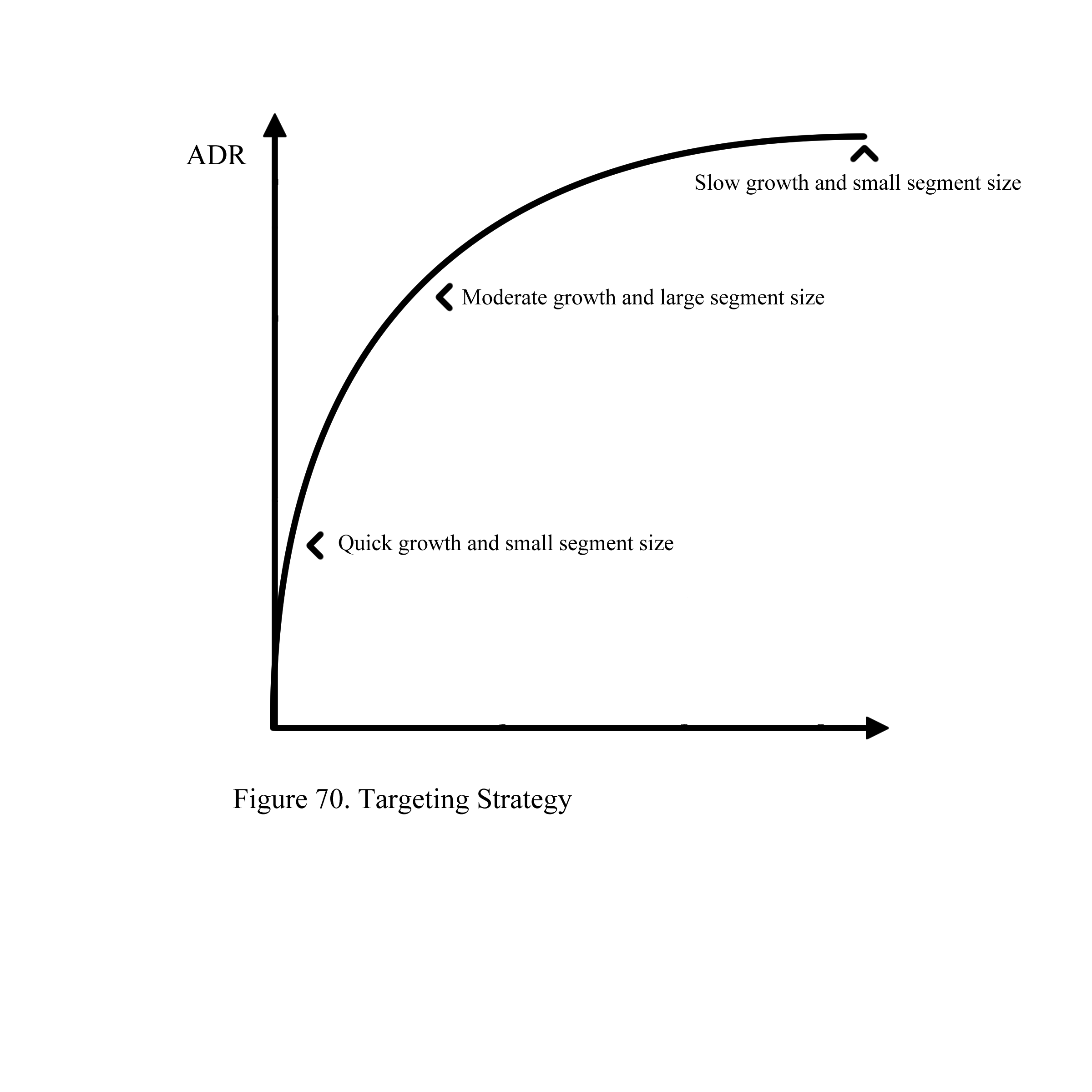
3.2. Market positioning
Market positioning is a strategic process where a hotel identifies its unique place in the market relative to its competitors. This involves analyzing various factors, such as price, amenities, quality, location, and customer service, to determine how the hotel can differentiate itself and appeal to its target market. Effective market positioning helps a hotel establish a clear and compelling identity that resonates with potential guests, setting it apart from other hotels in the area. Market positioning involves several key steps:
Competitive Analysis: The hotel conducts a thorough analysis of its direct competitors in the local market. This includes evaluating their offerings, pricing structures, customer reviews, and overall market presence. By understanding where competitors stand, the hotel can identify opportunities and areas for improvement.
Identifying Differentiators: Based on the competitive analysis, the hotel identifies its unique strengths and differentiators. These could include superior service, unique amenities, a distinctive location, or exceptional value. The goal is to find aspects of the hotel that can be highlighted to attract guests and differentiate it from competitors.
Developing a Positioning Statement: The hotel creates a clear and concise positioning statement that articulates its unique value proposition. This statement communicates the hotel’s key benefits and differentiators to its target audience, helping to shape marketing messages and brand identity.
Implementing Positioning Strategies: The hotel then implements strategies to reinforce its market position. This might involve adjustments to pricing, enhancing or adding amenities, improving service quality, or launching targeted marketing campaigns. The aim is to align the hotel’s offerings with its positioning statement and the needs of its target market.
Monitoring and Adjusting: Market positioning is not a one-time task but an ongoing process. The hotel continuously monitors its performance relative to competitors and market trends, making adjustments as needed to maintain or improve its position.
To illustrate market positioning, consider the example of two hotel brands: Holiday Inn and Hyatt. Both are prominent players in the hotel industry, but they target slightly different market segments and have distinct brand identities.
Competitive Analysis:
Holiday Inn: Known for its mid-scale, family-friendly accommodations, Holiday Inn offers a balance of comfort and affordability. The hotel typically provides standard amenities like free breakfast, a business center, and a pool, catering to both business and leisure travelers.
Hyatt: Hyatt, on the other hand, is recognized for its upscale, premium accommodations. Hyatt’s offerings often include higher-end amenities, such as gourmet dining, full-service spas, and state-of-the-art fitness centers. Hyatt targets both business executives and high-end leisure travelers seeking a more luxurious experience.
Identifying Differentiators:
Holiday Inn: To position itself effectively, Holiday Inn might focus on differentiators such as its value-for-money proposition, family-friendly features, and consistent quality across its locations. The hotel might also emphasize its convenient locations and practical amenities for families and business travelers.
Hyatt: Hyatt could highlight its upscale amenities, personalized services, and premium experiences as its key differentiators. The hotel might emphasize luxury, exclusivity, and high-end features like rooftop bars, wellness programs, and elegant room designs.
Developing a Positioning Statement:
Holiday Inn: “Affordable comfort and family-friendly amenities for business and leisure travelers.”
Hyatt: “Luxurious accommodations and exceptional service for discerning travelers seeking elegance and exclusivity.”
Implementing Positioning Strategies:
Holiday Inn: To strengthen its market position, Holiday Inn might enhance its value propositions, such as adding more family-oriented amenities (e.g., kids’ clubs, family suites) and offering loyalty rewards. Marketing campaigns could focus on promoting the hotel’s value and practicality.
Hyatt: Hyatt might continue to invest in its upscale amenities, such as expanding its wellness offerings or creating unique dining experiences. Marketing efforts could highlight the luxury and exclusivity of Hyatt properties, targeting high-income travelers seeking premium experiences.
Monitoring and Adjusting:
Both hotels would regularly review guest feedback, competitive performance, and market trends to ensure their positioning remains relevant. For example, if Holiday Inn receives feedback indicating that guests are seeking more upscale amenities, it might consider incorporating premium features. Conversely, if Hyatt notices emerging trends in eco-friendly travel, it might enhance its sustainability initiatives.
Market positioning is a strategic approach that helps hotels define their unique place in the market relative to competitors. By conducting a thorough competitive analysis, identifying key differentiators, and implementing targeted strategies, hotels can effectively position themselves to attract and retain their desired customer segments. This process not only helps hotels stand out in a crowded marketplace but also ensures that their offerings align with the needs and preferences of their target audience, ultimately leading to increased brand recognition, customer satisfaction, and business success (Figure 71).
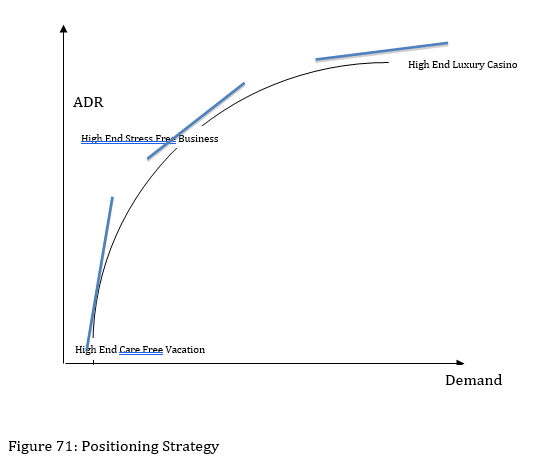
3.3. Market Promotion
Market promotion involves actively communicating and marketing a hotel’s brand, services, and unique offerings to potential customers within a specific geographic area. This strategy focuses on increasing the hotel’s visibility, attracting local patrons, and building a strong reputation within the community. By tailoring promotional activities to resonate with local residents and aligning with regional characteristics, hotels can effectively enhance their appeal and drive revenue from the local market.
Market promotion encompasses a variety of activities and strategies designed to create awareness, generate interest, and encourage patronage among the local community. The goal is to establish a strong local presence and foster positive relationships with residents and businesses in the area.
Local Branding and Identity:
Aligning with Regional Characteristics: Hotels can align their branding and promotional efforts with local characteristics, such as city colors, landmarks, or cultural themes. For example, if a city is known for its blue-themed décor, a hotel might incorporate blue into its design and marketing materials to create a sense of local relevance and connection.
Community Involvement: Engaging with the local community through sponsorships, partnerships, and participation in local events can help build brand recognition and loyalty. For instance, a hotel might sponsor local festivals, charity events, or sports teams to increase its visibility and demonstrate support for the community.
Targeted Local Advertising:
Local Media: Utilizing local media channels, such as newspapers, radio stations, and community websites, allows hotels to reach residents directly. Advertising campaigns might include promotions, special offers, and events tailored to local interests and preferences.
Digital Marketing: Localized digital marketing strategies, such as geo-targeted ads and social media campaigns, can effectively reach residents in specific areas. By using platforms like Facebook, Instagram, and Google Ads, hotels can target local audiences with customized messages and promotions.
Special Offers and Promotions:
Local Discounts and Packages: Offering special discounts or packages specifically for local residents can encourage them to choose the hotel for staycations, events, or dining experiences. For example, a hotel might provide discounted rates for local residents or create special weekend packages that include dining and entertainment options.
Loyalty Programs: Implementing loyalty programs that reward local guests for frequent visits can help build long-term relationships and encourage repeat business. Rewards might include points for free stays, dining discounts, or exclusive access to events.
Community Engagement and Events:
Hosting Local Events: Organizing events such as community fairs, business networking functions, or cultural celebrations at the hotel can attract local residents and create a positive association with the brand. These events provide an opportunity for residents to experience the hotel’s amenities and services firsthand.
Collaborations with Local Businesses: Partnering with local businesses, such as restaurants, shops, and attractions, to offer joint promotions or packages can enhance the hotel’s appeal and provide additional value to guests. For instance, a hotel might collaborate with a nearby restaurant to offer a combined dining and lodging package.
Personalized Customer Engagement:
Feedback and Reviews: Actively seeking feedback from local guests and responding to reviews can help the hotel improve its services and demonstrate a commitment to customer satisfaction. Positive reviews and word-of-mouth recommendations from local residents can significantly boost the hotel’s reputation.
Tailored Experiences: Creating personalized experiences based on local knowledge and preferences can enhance the guest experience. For example, a hotel might offer curated local tours, recommend neighborhood attractions, or provide information about local events and activities.
Imagine a hotel located in a coastal city known for its vibrant blue-themed décor and seaside attractions. To effectively promote itself within the local market, the hotel might:
Incorporate City Colors: Design the hotel’s exterior and interior spaces with a blue color scheme that reflects the city’s aesthetic. This alignment with the local theme can create a sense of connection with residents and enhance the hotel’s appeal.
Local Media Campaign: Launch a targeted advertising campaign in local newspapers, radio stations, and social media platforms. The campaign might feature special offers for local residents, such as discounted rates for weekend stays or promotional packages that include tickets to nearby attractions.
Host Community Events: Organize events such as beach clean-ups, local art exhibits, or seasonal festivals at the hotel. These events can attract local residents and provide opportunities for them to experience the hotel’s amenities while engaging with the community.
Collaborate with Local Businesses: Partner with local restaurants and shops to offer exclusive discounts or packages. For example, the hotel might create a package that includes a stay and a dining experience at a nearby seafood restaurant, promoting both businesses and providing added value to guests.
Market promotion is a strategic approach to increasing a hotel’s visibility and appeal within a specific geographic area. By aligning with local characteristics, engaging with the community, and implementing targeted advertising and promotional efforts, hotels can build a strong local presence and drive revenue from the local market. Effective market promotion not only enhances brand recognition but also fosters positive relationships with residents, leading to increased loyalty and long-term success (Figure 72).
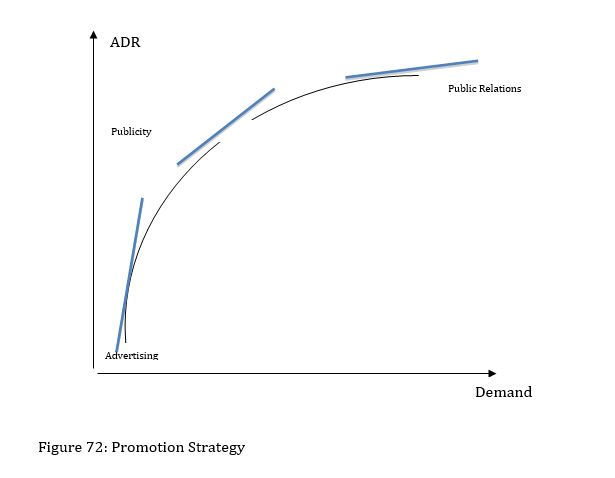
4. Change the mix between supply and demand
Marketing to change the mix between supply and demand involves using various strategies and tactics to adjust the balance between the availability of a hotel’s products and services (supply) and the desires or needs of potential guests (demand). The goal is to align supply with demand in a way that maximizes occupancy, revenue, and customer satisfaction.
Supply refers to the total number of rooms, amenities, and services that a hotel offers. This includes the physical capacity of the hotel, such as the number of guest rooms, the range of amenities (like pools, gyms, and conference facilities), and the types of services provided (such as room service, concierge, and event hosting).
Demand refers to the level of interest and need for the hotel’s offerings. This can be influenced by various factors including seasonality, economic conditions, local events, and changing consumer preferences. For example, demand might peak during a major local event or holiday season and decline during off-peak times.
Strategies to Change the Mix Between Supply and DemandAdjust Rates Based on Demand: Implement dynamic pricing strategies where room rates fluctuate based on real-time demand. During high-demand periods (e.g., holidays, major events), increase prices to maximize revenue. Conversely, during low-demand periods, lower prices to attract more guests.
Promotional Offers: Create special promotions or discounts to stimulate demand during slower periods. This could include limited-time offers, package deals, or last-minute booking discounts to fill rooms that would otherwise remain vacant.
Modify Supply Based on Seasonality: Adjust the hotel’s offerings and availability based on seasonal demand. For example, during peak tourist seasons, open additional rooms or offer seasonal amenities (like outdoor pools or summer activities) to cater to increased demand. During off-peak seasons, consider closing certain areas or reducing the number of available rooms to match lower demand. Develop targeted marketing campaigns that promote seasonal offers and activities. Highlight seasonal attractions, special events, and unique experiences available at the hotel during different times of the year.
Leverage Local Events: Increase supply or create special packages around local events, such as festivals, conferences, or sports games. For example, offer special rates or packages that include tickets to a local event, catering to guests who are visiting the area specifically for that event.
Host Events: Use the hotel’s facilities to host events or activities that can attract local and regional visitors. This could include weddings, business meetings, or community gatherings, which can drive demand and fill rooms.
Identify and Target Specific Segments: Use market segmentation to target specific customer groups with tailored marketing messages. For example, promote family-friendly packages to attract families during school holidays or offer business traveler packages during weekdays.
Localized Promotions: Create marketing campaigns that appeal to local residents or nearby markets. For example, offer “staycation” packages with special rates for local residents, or run promotions in nearby cities to attract visitors.
Enhance the hotel’s value proposition by improving the quality of services, adding unique amenities, or offering personalized experiences. By providing added value, the hotel can increase demand even if prices are higher.
Collect and Act on Feedback: Use guest feedback to make improvements that can boost satisfaction and attract more guests. For example, if guests frequently request certain amenities or services, consider adding those features to better meet demand.
Optimize Room Availability: Manage room inventory to ensure that the hotel’s supply aligns with demand. This might involve adjusting booking policies, such as requiring minimum stay lengths during high-demand periods or offering flexible cancellation policies during slower periods.
Adjust Service Offerings: Modify the range of services available based on current demand. For example, during periods of high occupancy, offer additional amenities such as extra housekeeping services or extended dining hours to enhance the guest experience.
Imagine a hotel located in a city with a major annual festival that significantly boosts demand for accommodations. To effectively manage the supply and demand mix, the hotel might: Increase room rates during the festival period to take advantage of the high demand. Conversely, offer discounted rates or special promotions in the months leading up to the festival to attract early bookings and maintain a steady flow of guests. During the festival, open additional rooms or offer upgraded amenities, such as festival-themed decorations or special event packages. After the festival, reduce the number of available rooms or close off certain areas to align with lower demand.
Partner with the festival organizers to offer exclusive packages that include tickets to the event, transportation, and other perks. Host related activities or pre-festival events at the hotel to draw in more guests. Run targeted advertising campaigns focusing on festival-goers and tourists coming to the city for the event. Create special offers and highlight the hotel’s proximity to the festival venue. Offer festival-related amenities, such as themed welcome gifts or local cuisine, to enhance the guest experience and attract more attendees.
Changing the mix between supply and demand through marketing strategies is essential for optimizing a hotel’s performance and profitability. By employing dynamic pricing, adjusting supply based on seasonality, leveraging local events, and tailoring marketing efforts, hotels can effectively balance their offerings with market demand. This approach not only helps maximize revenue and occupancy but also enhances the overall guest experience, ensuring long-term success in a competitive industry. The following are illustrated images of customer relationship management and the mix of market management.
4.1. Customer relationship management
Customer Relationship Management (CRM) is a comprehensive approach and system designed to manage and optimize interactions with customers, aiming to build and sustain long-term loyalty. In the context of the hotel industry, CRM systems and strategies are employed to enhance guest experiences, increase retention rates, and ultimately drive profitability through personalized service and targeted engagement.
CRM encompasses a range of practices, technologies, and strategies that enable hotels to effectively track and manage guest interactions and data throughout the guest lifecycle. The goal is to foster positive relationships, improve guest satisfaction, and encourage repeat business. Effective CRM involves using data and insights to tailor services, anticipate guest needs, and create a personalized experience.
Guest Profiles: CRM systems collect and store detailed profiles of guests, including personal information, stay history, preferences, and feedback. This information helps hotels understand their guests’ needs and preferences.
Behavioral Insights: Analyzing data on guest behavior, such as booking patterns, spending habits, and service usage, provides valuable insights for tailoring marketing efforts and improving service delivery.
Personalized Communication:
Targeted Marketing: Use CRM data to segment guests and create personalized marketing campaigns. For example, send targeted offers based on past stays, preferences, or upcoming anniversaries.
Customized Service: Leverage guest data to offer personalized services and amenities. For instance, a guest who frequently stays for business might appreciate expedited check-in or a dedicated workspace in their room.
Loyalty Programs:
Points Systems: Implement loyalty programs where guests earn points for each stay or specific actions, such as booking directly through the hotel’s website. Points can be redeemed for rewards like free nights, upgrades, or exclusive offers.
Tiered Rewards: Develop a tiered loyalty program with different levels of benefits. For example, frequent guests might move from a basic level to a premium tier, receiving additional perks such as priority check-in, room upgrades, or access to exclusive lounges.
Feedback and Improvement:
Guest Surveys: Collect feedback through surveys or review platforms to gauge guest satisfaction and identify areas for improvement. Use this feedback to make enhancements and address any issues promptly.
Response Management: Implement a system for responding to guest inquiries and complaints efficiently. Prompt and effective resolution of issues contributes to a positive guest experience and fosters loyalty.
Engagement and Retention:
Special Offers: Create exclusive offers or discounts for repeat guests to incentivize return visits. For instance, offer a discount on their next stay after a certain number of visits.
Personalized Greetings: Use guest data to provide personalized greetings or special touches during their stay, such as a welcome note or a preferred room setup.
Consider a hotel chain that uses a CRM system to enhance guest relationships and build loyalty. Here’s how they might implement various CRM strategies:
Data Collection and Analysis:
The hotel chain collects data on guest preferences, including room types, favorite amenities, and special requests. They also track booking patterns, such as frequent visit dates or preferred check-in times.
Personalized Communication:
Using CRM data, the hotel sends personalized email offers to guests, such as special rates for their favorite room type or tailored promotions based on their stay history. For example, if a guest frequently books spa treatments, they might receive an offer for a discounted spa package.
Loyalty Program:
The hotel chain implements a points-based loyalty program where guests earn points for each stay. Accumulated points can be redeemed for rewards such as free nights, dining credits, or room upgrades. The program also features tiers, where frequent guests receive additional perks like early check-in or late check-out privileges.
Feedback and Improvement:
After each stay, guests receive a survey asking about their experience. The hotel uses this feedback to make improvements, such as enhancing room amenities or adjusting service protocols. They also promptly address any negative feedback to resolve issues and improve guest satisfaction.
Engagement and Retention:
The hotel chain offers a special promotion for guests who have stayed at least five times, providing them with a discount on their next stay or a complimentary room upgrade. They also send personalized birthday greetings and exclusive offers to encourage repeat visits.
Benefits of Customer Relationship Management
Increased Guest Loyalty: By providing personalized experiences and rewards, hotels can build stronger relationships with guests, leading to increased loyalty and repeat business.
Enhanced Guest Satisfaction: Tailoring services and addressing guest preferences and feedback contributes to a more satisfying stay, which can lead to positive reviews and referrals.
Improved Revenue: Effective CRM strategies can drive revenue through repeat bookings, upselling opportunities, and targeted promotions that resonate with guests.
Efficient Operations: CRM systems streamline guest interactions and service delivery, making it easier for hotel staff to manage reservations, handle requests, and resolve issues.
Data-Driven Decisions: CRM provides valuable insights into guest behavior and preferences, enabling hotels to make informed decisions and optimize their marketing and service strategies.
Customer Relationship Management is a vital strategy for hotels looking to build and maintain strong relationships with their guests. By leveraging data, personalizing interactions, and implementing effective loyalty programs, hotels can enhance guest satisfaction, drive repeat business, and ultimately achieve greater success in a competitive market. CRM systems and practices help hotels understand and respond to guest needs, creating memorable experiences that foster loyalty and support long-term growth (Figure 73).
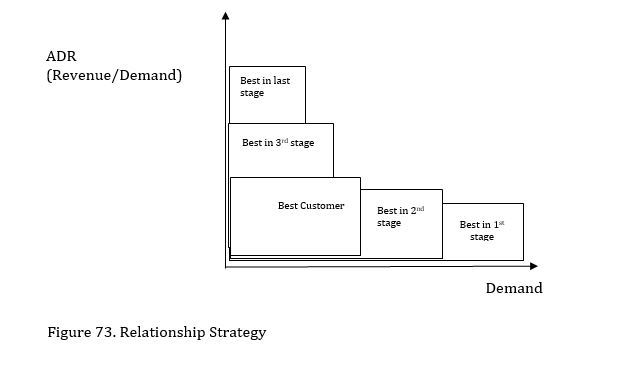
4.2. Mix of Market segment
The Mix of Market Segments refers to the various customer segments that collectively comprise a hotel’s total business. Understanding and managing these segments effectively is crucial for maximizing revenue and profit opportunities, as different segments have distinct behaviors, preferences, and spending patterns. The mix of market segments can be divided into five key components, each addressing a different aspect of customer segmentation and management (Figure 74).
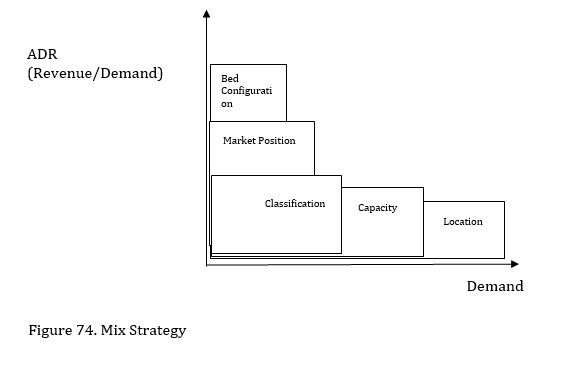
Location:
Understanding Geographic Origins: This component involves analyzing where the hotel’s customers are coming from geographically. By identifying the primary locations of guests, the hotel can tailor its marketing efforts to focus on these regions.
Targeted Advertising: Hotels can optimize their advertising strategies by targeting specific geographic areas with higher potential for bookings. For instance, if most guests are from a particular city or region, the hotel might invest in local advertising, digital marketing campaigns, or partnerships with travel agencies in those areas.
Local Partnerships: Collaborate with local businesses or tourism boards in the key geographic areas to enhance visibility and attract more guests from those regions (Figure 75).
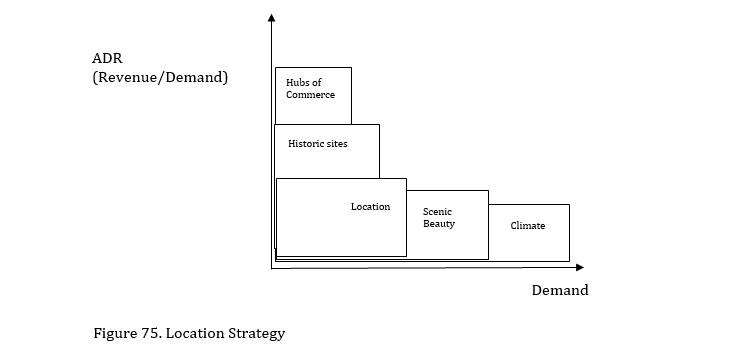
Capacity:
Comparing Market Segments: This aspect involves evaluating different market segments to determine which ones offer the greatest potential. For example, a hotel might compare two large customer groups, such as business travelers and tourists, to see which segment has a larger volume or higher revenue potential.
Allocation of Resources: Based on the analysis, the hotel can prioritize the larger or more lucrative segment by adjusting its capacity and resources. For example, if the business traveler segment is larger and more profitable, the hotel might focus on expanding its business amenities and services.
Dynamic Pricing: Implement pricing strategies that align with the demand and capacity of different segments, ensuring that the hotel maximizes revenue while accommodating the preferred customer group (Figure 76).
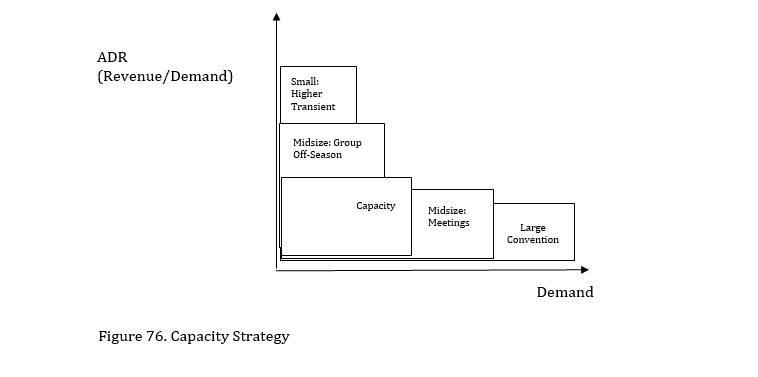
Position:
Segment Preferences: This component involves evaluating the desirability of different customer segments based on their willingness to spend. For instance, higher-class guests typically have higher spending power and may be willing to pay more for premium services.
Service and Pricing Strategies: Adjust the hotel’s offerings and pricing strategies to attract and cater to higher-class guests. This might include offering luxury amenities, personalized services, and exclusive experiences that appeal to affluent customers.
Market Positioning: Position the hotel in a way that attracts the desired segment while differentiating from competitors. For example, a hotel might emphasize its upscale amenities and high-end services in marketing materials to appeal to a higher-class clientele (Figure 77).
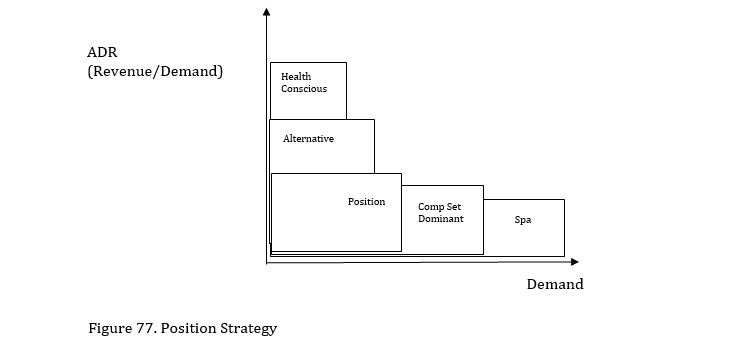
Bed Configuration:
Pricing Models: Decide whether to charge based on the number of people or the number of beds. This decision impacts how the hotel structures its pricing and manages room configurations.
Flexible Room Layouts: Offer flexible bed configurations and pricing options to cater to different types of guests, such as families, groups, or solo travelers. For example, a hotel might provide options for adding extra beds or converting rooms to accommodate larger groups.
Revenue Optimization: Analyze booking patterns to determine the most profitable bed configuration and pricing model. This could involve testing different approaches to see which yields the highest revenue and guest satisfaction (Figure 78).
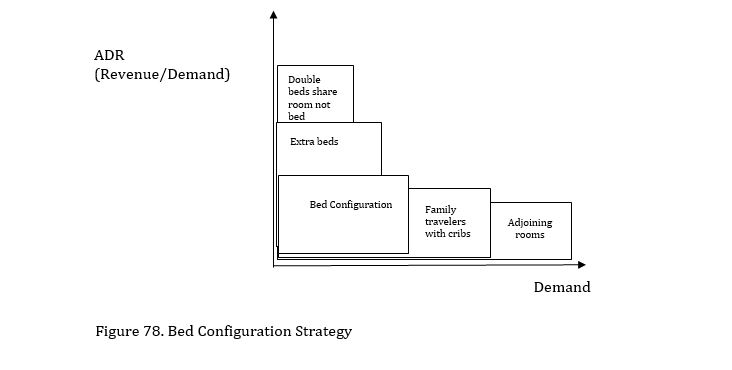
Ambiance:
Creating Value: This component focuses on the hotel’s ability to create a high-class environment at a relatively low cost. This involves designing a pleasant and upscale ambiance without significantly increasing expenses.
Cost-Effective Design: Invest in cost-effective design elements and décor that enhance the hotel’s atmosphere and appeal to higher-class guests. This might include stylish but affordable furnishings, attractive lighting, and elegant yet budget-friendly décor.
Guest Experience: Ensure that the ambiance contributes to a positive guest experience by creating a comfortable and aesthetically pleasing environment. A well-crafted ambiance can enhance the perceived value of the hotel, even if it is not the most expensive (Figure 79).
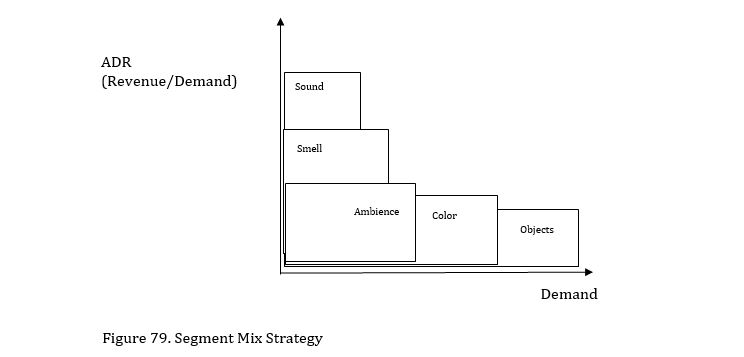
Consider a hotel that wants to optimize its mix of market segments:
Location: The hotel notices that a significant number of its guests come from a neighboring city. It decides to focus its marketing efforts on this city by running targeted ads and collaborating with local travel agencies to attract more visitors.
Capacity: The hotel finds that business travelers are more numerous and spend more on average than leisure tourists. It decides to allocate more resources to improving business facilities and services, such as offering better meeting rooms and business amenities.
Position: The hotel wants to attract more high-class guests who are willing to pay a premium. It enhances its luxury offerings, such as adding a high-end spa, upgrading room amenities, and emphasizing these features in its marketing campaigns.
Bed Configuration: The hotel tests two pricing models: one based on the number of people and another based on the number of beds. It finds that the bed-based model is more profitable for family bookings, so it adjusts its pricing accordingly.
Ambiance: The hotel redesigns its lobby and common areas to create a more upscale feel while keeping costs low. It uses stylish yet affordable furnishings and décor to enhance the guest experience without significantly increasing expenses.
Effectively managing the mix of market segments is crucial for optimizing a hotel’s business performance. By focusing on location, capacity, position, bed configuration, and ambiance, hotels can tailor their strategies to meet the needs of different customer segments, maximize revenue, and enhance guest satisfaction. Each component plays a role in how the hotel attracts, serves, and retains various types of guests, contributing to overall success and profitability.
5. Strategic Pricing
Strategic pricing involves setting room rates and pricing structures based on various factors related to guest behavior, market conditions, and competitive positioning (Figure 80).
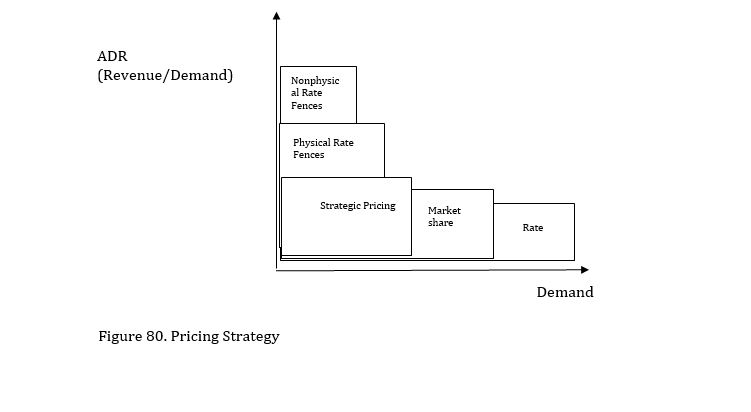
The goal is to optimize revenue and profitability while accommodating different customer segments and preferences. Strategic pricing can be implemented through several methods, each with its own approach and objectives. The four main types of strategic pricing are nonphysical rate fences, physical rate fences, market share pricing, and rate parity.
Types of Strategic Pricing
Nonphysical Rate Fences:
Definition: Nonphysical rate fences are pricing strategies that create distinctions between different customer segments based on intangible factors or conditions. These are often used to segment the market and offer different pricing based on guest characteristics or behaviors rather than physical attributes.
Examples:
Advanced Purchase Discounts: Offering lower rates to guests who book their stay well in advance. This incentivizes early bookings and helps manage inventory.
Membership Rates: Providing special rates or discounts to members of a loyalty program or industry association. This rewards loyal guests and encourages repeat business.
Corporate Rates: Offering discounted rates to corporate clients or business travelers who have agreements with the hotel. This helps attract and retain business accounts (Figure 81).
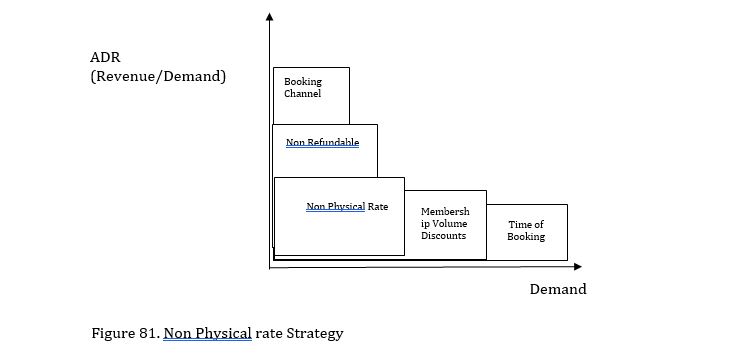
Physical Rate Fences:
Definition: Physical rate fences involve tangible or physical attributes that differentiate pricing. These attributes directly affect the guest experience and are used to create distinct pricing tiers.
Examples:
Room Types: Charging different rates for various room types, such as standard rooms, deluxe rooms, or suites. Higher-tier rooms with additional amenities or better views command higher prices.
Amenities and Services: Offering different rates based on the inclusion of certain amenities or services, such as breakfast, spa access, or parking. Guests can choose a package that includes the amenities they value most.
View and Location: Setting higher rates for rooms with premium views, such as oceanfront or cityscape views, compared to standard rooms with less desirable views (Figure 82).
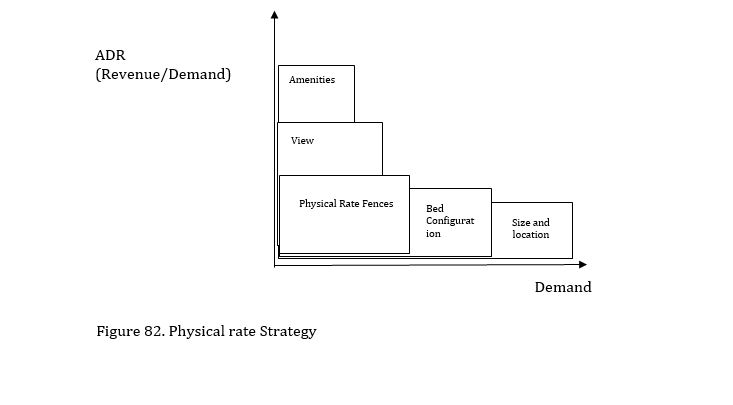
Market Share Pricing:
Definition: Market share pricing involves setting rates based on the hotel’s objective to capture a larger share of the market. This pricing strategy is often used to increase occupancy or gain competitive advantage in a specific market segment.
Examples:
Competitive Pricing: Adjusting rates to be competitive with other hotels in the area to attract more guests. For example, pricing rooms slightly lower than competitors to draw in budget-conscious travelers.
Promotional Rates: Implementing temporary discounts or promotions to boost occupancy during off-peak periods. This can include seasonal offers, flash sales, or limited-time deals.
Volume Discounts: Offering reduced rates for group bookings, conferences, or extended stays to encourage larger reservations and increase market share (Figure 83).
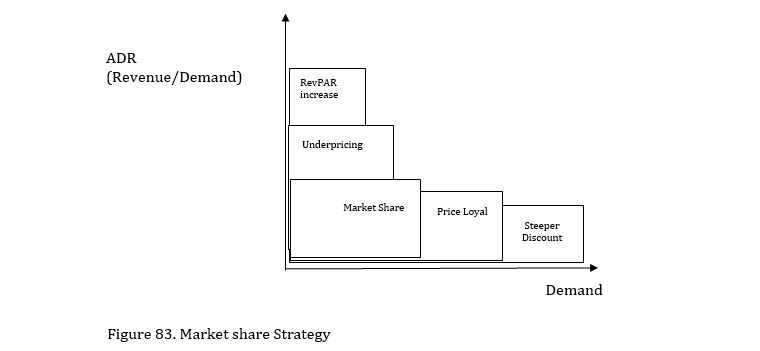
Rate Parity:
Definition: Rate parity is the practice of ensuring that the hotel’s room rates are consistent across all distribution channels and booking platforms. This strategy helps maintain uniformity in pricing and avoid discrepancies that could confuse or alienate customers.
Examples:
Uniform Pricing: Setting the same room rates on the hotel’s website, online travel agencies (OTAs), and other distribution channels. This prevents discrepancies and ensures that guests receive the same rate regardless of where they book.
Best Rate Guarantee: Offering a guarantee that the hotel’s website provides the lowest available rate. This encourages guests to book directly through the hotel’s site while ensuring price consistency.
Channel Management: Using channel management systems to synchronize rates across multiple booking platforms. This helps manage rate parity and reduces the risk of overbooking or rate discrepancies (Figure 84).
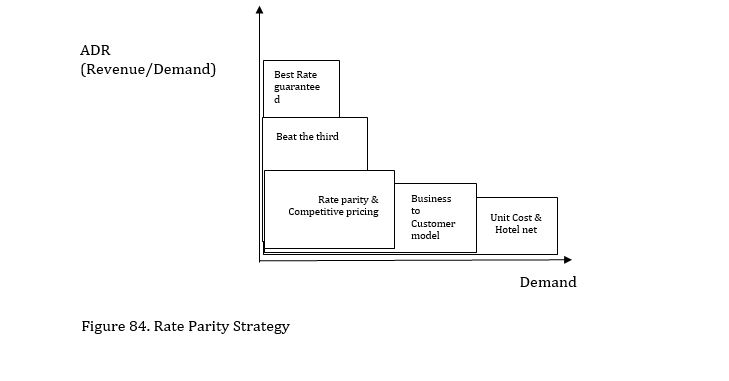
Examples of Strategic Pricing in Action
Nonphysical Rate Fences:
A hotel offers a discount for guests who book their stays at least 30 days in advance, targeting travelers who plan ahead. It also provides exclusive rates to members of its loyalty program, rewarding frequent guests with lower prices and additional perks.
Physical Rate Fences:
The hotel sets higher rates for suites compared to standard rooms, reflecting the added space and luxury amenities. It also offers packages that include breakfast or spa access at a higher price point, catering to guests who desire these additional services.
Market Share Pricing:
During a slow season, the hotel implements a promotional rate to attract more guests and increase occupancy. It also adjusts its pricing to be slightly lower than nearby competitors to draw in budget-conscious travelers.
Rate Parity:
The hotel ensures that the room rates are consistent across its own website and major OTAs. It uses a channel management system to synchronize rates and offers a best rate guarantee to encourage direct bookings and maintain pricing uniformity.
Strategic pricing is a crucial aspect of revenue management in the hotel industry. By employing nonphysical and physical rate fences, market share pricing, and rate parity, hotels can effectively manage their pricing strategies to attract different customer segments, optimize occupancy, and enhance profitability. Each approach has its own benefits and applications, and the choice of strategy depends on the hotel’s objectives, market conditions, and competitive landscape. Implementing these strategies thoughtfully can lead to better financial performance and a stronger market position.
6. Marketing Change Revenue
Marketing Change Revenue refers to the impact that various marketing strategies and adjustments have on a hotel’s revenue generation. Changes in marketing tactics can significantly influence a hotel’s ability to attract guests, increase bookings, and maximize income. Here’s an expanded view of how marketing changes can affect revenue, including specific strategies and examples:
Key Areas Where Marketing Changes Impact Revenue
Target Market Segmentation
Definition: Tailoring marketing efforts to different customer segments can lead to more effective promotions and higher conversion rates.
Examples:
Luxury Segment: Implementing targeted campaigns for high-income guests through luxury travel magazines or exclusive social media channels can attract more affluent customers, potentially increasing revenue through higher room rates and premium services.
Family Segment: Promoting family-friendly packages and amenities through parenting blogs and family travel sites can attract more families, boosting occupancy and revenue through family-oriented add-ons and extended stays.
Promotional Strategies
Discounts and Offers: Introducing limited-time promotions or discounts can drive immediate bookings and increase revenue.
Flash Sales: Running flash sales with substantial discounts for a short period can boost bookings during slow periods.
Seasonal Promotions: Offering special packages or discounts during peak travel seasons or holidays can attract more guests and increase revenue.
Bundling: Creating bundled packages that combine room stays with additional services such as dining, spa treatments, or local tours can increase average revenue per guest.
Example: A hotel might offer a “Romantic Getaway” package that includes a room upgrade, a gourmet dinner, and a couples’ massage, enticing guests to spend more.
Channel Management
Online Travel Agencies (OTAs): Adjusting pricing and promotions across different OTAs can influence booking volumes and revenue.
Rate Parity: Ensuring consistent pricing across OTAs and the hotel’s direct booking channels helps maintain guest trust and prevents rate discrepancies that could impact revenue.
Exclusive Offers: Providing exclusive offers or perks for direct bookings can drive more guests to book directly, improving revenue by avoiding OTA commission fees.
Revenue Management
Dynamic Pricing: Adjusting room rates based on demand, time of booking, and market conditions can optimize revenue.
Example: Implementing dynamic pricing strategies that increase rates during high-demand periods (such as local events or peak seasons) and decrease rates during low-demand periods can maximize occupancy and revenue.
Upselling and Cross-Selling: Offering guests opportunities to upgrade their room or purchase additional services can boost revenue.
Example: During the booking process, a hotel might offer an upgrade to a suite or additional amenities such as airport transfers or early check-in for a fee.
Brand Positioning and Messaging
Rebranding: A successful rebranding campaign can attract new customer segments and increase revenue.
Example: A hotel that repositions itself as a luxury destination through a branding campaign and updates its decor and services to match can attract higher-income guests and command higher rates.
Content Marketing: Creating engaging content that showcases the hotel’s unique features and experiences can attract more guests.
Example: Publishing blog posts, videos, and social media content highlighting local attractions, guest experiences, and special events can draw more interest and bookings.
Customer Experience and Loyalty
Personalization: Enhancing guest experiences through personalized services and offers can lead to repeat business and increased revenue.
Example: A hotel that uses CRM data to personalize welcome messages, room amenities, and special offers based on guest preferences can improve guest satisfaction and encourage repeat stays.
Loyalty Programs: Implementing or enhancing loyalty programs can increase revenue by encouraging repeat bookings and generating additional spend.
Example: Offering rewards points for each stay, which can be redeemed for free nights or upgrades, incentivizes guests to book more frequently and spend more during their stays.
Examples of Marketing Changes Impacting Revenue
Dynamic Pricing Implementation:
Scenario: A hotel introduces a dynamic pricing model that adjusts room rates based on real-time demand and booking patterns.
Impact: During peak seasons, rates are increased, leading to higher revenue per booking. Conversely, during slower periods, rates are reduced to attract more guests, improving overall occupancy and revenue.
Targeted Social Media Campaign:
Scenario: A hotel launches a targeted social media campaign promoting a new spa package to local residents.
Impact: The campaign successfully attracts local guests for day-use services, increasing revenue through spa treatments and dining options.
Bundled Package Offer:
Scenario: A resort creates an all-inclusive package that includes accommodation, meals, and activities.
Impact: The package attracts families and groups, leading to higher revenue per booking compared to standard room-only reservations.
Rebranding Effort:
Scenario: A mid-range hotel undergoes a rebranding to position itself as a boutique luxury property.
Impact: The rebranding attracts higher-income guests and allows the hotel to increase its room rates, leading to a significant boost in revenue.
Marketing changes play a pivotal role in influencing a hotel’s revenue by targeting specific customer segments, adjusting pricing strategies, managing distribution channels, and enhancing the overall guest experience. By implementing and refining marketing strategies across these areas, hotels can effectively increase bookings, optimize revenue, and achieve financial success. Adapting marketing tactics to align with market trends, guest preferences, and competitive dynamics is key to driving revenue growth and maintaining a strong market position. Following are the 3 popular marketing strategies to change revenue by revenue stream management, strategic marketing, and packaging process.
6.1. Revenue streams management
Revenue Streams Management focuses on maximizing a hotel’s income by managing and optimizing various sources of revenue beyond just room rates. This approach involves understanding and leveraging a guest’s potential total spend, including ancillary services and products, to enhance overall profitability. Here’s an expanded view of how to manage revenue streams based on a customer’s potential total spend:
Key Concepts in Revenue Streams Management
Comprehensive Revenue Analysis
Definition: Analyzing all potential sources of revenue, not just room rates, to understand a guest’s total spend and value.
Examples:
Ancillary Services: Track revenue from services such as dining, spa treatments, parking, and excursions.
Guest Behavior Analysis: Use data analytics to assess guest preferences and spending patterns across various services.
Personalized Upselling and Cross-Selling
Definition: Offering additional services or products that complement the guest’s stay and enhance their overall experience.
Examples:
Upselling: Promote room upgrades or premium room features that offer enhanced comfort and amenities.
Cross-Selling: Suggest additional services like dining packages, spa treatments, or guided tours based on the guest’s interests or past behavior.
Dynamic Pricing and Package Offerings
Definition: Adjusting pricing and creating packages that reflect the guest’s potential total spend and preferences.
Examples:
Dynamic Pricing: Implement pricing strategies that adjust based on demand for rooms and ancillary services, optimizing revenue from high-spending guests.
Packages: Develop tailored packages that include room rates, meals, activities, and other services, providing a comprehensive experience while increasing total spend.
Loyalty and Rewards Programs
Definition: Encouraging repeat business and higher spend through loyalty and rewards programs that offer incentives for additional purchases.
Examples:
Points Systems: Offer points for every dollar spent on room rates and ancillary services, which can be redeemed for free stays or discounts.
Exclusive Offers: Provide special offers or discounts on additional services to loyalty program members, encouraging them to spend more during their stay.
Revenue Management Technologies
Definition: Utilizing technology and data analytics to optimize pricing, forecast demand, and manage various revenue streams.
Examples:
Property Management Systems (PMS): Use PMS to track and analyze guest spending across different revenue streams.
Customer Relationship Management (CRM): Leverage CRM data to personalize offers and promotions based on guest preferences and spending history.
Enhancing Guest Experience
Definition: Improving the overall guest experience to increase their likelihood of spending more on additional services.
Examples:
Personalized Service: Tailor guest interactions and service offerings based on their preferences and feedback, enhancing satisfaction and increasing their willingness to spend on premium services.
Convenience and Comfort: Offer conveniences such as easy booking for extra services, and ensure high standards of comfort and quality to encourage guests to indulge in additional purchases.
Examples of Managing Revenue Streams Based on Total Spend
Dynamic Room and Service Pricing:
Scenario: A hotel adjusts room rates dynamically based on real-time demand and guest profiles, and offers personalized pricing for additional services like dining and spa treatments.
Impact: By optimizing room rates and promoting high-margin services, the hotel can increase overall revenue from guests who are willing to spend more.
Customized Packages:
Scenario: A resort creates a tailored package for a honeymoon couple that includes a luxury room, romantic dinners, spa treatments, and private excursions.
Impact: This all-inclusive approach increases the total spend per guest while enhancing their overall experience, leading to higher revenue and guest satisfaction.
Loyalty Program Enhancements:
Scenario: A hotel chain enhances its loyalty program by offering additional points for spending on dining, activities, and room upgrades.
Impact: The program incentivizes guests to spend more on ancillary services, resulting in increased total revenue and repeat business.
Personalized Upselling:
Scenario: During the booking process, a hotel offers guests the option to upgrade to a suite or add services such as airport transfers or exclusive access to amenities.
Impact: By presenting relevant upsell options, the hotel can boost the total spend of each guest while improving their overall experience.
Revenue Optimization through Technology:
Scenario: A hotel uses a CRM system to analyze guest data and offers personalized promotions for dining and spa services based on past spending patterns.
Impact: Targeted promotions increase the likelihood of additional purchases, optimizing total revenue from each guest.
Managing revenue streams effectively involves looking beyond room rates to understand and optimize a guest’s potential total spend. By employing strategies such as personalized upselling, dynamic pricing, customized packages, and leveraging technology, hotels can enhance their overall revenue. Focused efforts on maximizing ancillary revenue, enhancing guest experiences, and utilizing data-driven insights can lead to significant improvements in profitability and guest satisfaction (Figure 85).
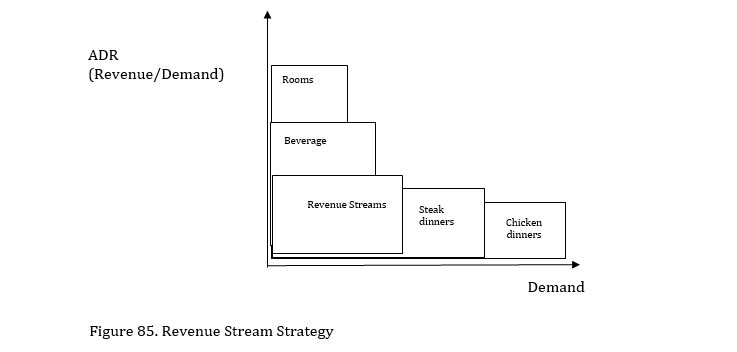
6.2. Strategic packaging
Bundling goods or services is a strategic marketing approach in the hospitality industry where hotels combine various offerings into a single package, providing guests with perceived added value while encouraging higher spending on-site. This strategy aims to enhance the guest experience, optimize revenue, and reduce the likelihood of guests seeking alternatives outside the hotel. Here’s an expanded view of how bundling works and its strategic implications:
Understanding Bundling
Definition: Bundling involves grouping multiple products or services together and offering them at a combined price that is often lower than the sum of their individual prices. This approach can be used to enhance the attractiveness of a hotel’s offering by delivering a greater perceived value to guests.
Benefits of Bundling
Enhanced Perceived Value
Definition: Bundling offers guests a comprehensive package at a reduced price compared to purchasing each component separately, enhancing the perceived value.
Example: A hotel offers a room rate of $100 and a $50 dining credit for an additional $40, totaling $140 for a package worth $150. Guests perceive they are saving $10, making it an attractive deal.
Increased On-Site Spending
Definition: Bundling encourages guests to use more of the hotel’s services and amenities rather than seeking alternatives off-property.
Example: By including a dining credit in the package, the hotel ensures that guests dine at the hotel restaurant, boosting revenue from food and beverage services.
Enhanced Guest Experience
Definition: Bundles can improve the guest experience by providing convenience and a seamless stay with all needs addressed in one package.
Example: A “Romantic Escape” package including a luxury room, dinner for two, and a couple’s massage offers a complete experience, reducing the need for guests to make additional arrangements.
Competitive Advantage
Definition: Offering well-designed bundles can differentiate a hotel from competitors, making it a more appealing choice for potential guests.
Example: A hotel might bundle a room with tickets to a local attraction, setting itself apart from competitors who do not offer such packages.
Increased Booking Rate
Definition: Attractive bundles can drive higher booking rates by offering perceived savings and added value, encouraging guests to book the package rather than individual services.
Example: A family package that includes accommodations, meals, and tickets to a nearby amusement park might attract families looking for convenience and value, leading to higher bookings.
Examples of Strategic Bundling
Room and Dining Packages
Scenario: A hotel offers a package that includes a standard room, a $50 dining credit, and a $20 parking voucher for a total of $140.
Impact: Guests perceive they are getting $170 worth of value for $140, which increases the likelihood of dining in the hotel restaurant and using hotel parking facilities.
Wellness and Relaxation Packages
Scenario: A spa resort offers a package that includes accommodation, daily yoga classes, and a spa treatment for a combined price.
Impact: The package provides guests with a complete wellness experience, encouraging them to spend more on additional spa services and activities.
Corporate and Meeting Packages
Scenario: A hotel provides a business package that includes room accommodations, meeting room rental, and catering services.
Impact: This package appeals to corporate clients looking for convenience and cost savings, driving revenue from both accommodation and meeting services.
Family Vacation Bundles
Scenario: A family-friendly hotel offers a vacation bundle that includes lodging, breakfast, and tickets to a local theme park.
Impact: This bundle attracts families by offering a convenient and cost-effective solution, encouraging them to spend more on-site and enjoy a complete family experience.
Romantic Getaway Packages
Scenario: A hotel offers a romantic getaway package that includes a room upgrade, a gourmet dinner for two, and a bottle of champagne.
Impact: The package targets couples looking for a special experience, increasing revenue from dining and room upgrades while enhancing guest satisfaction.
Implementation Strategies
Market Research and Analysis
Definition: Conduct research to understand guest preferences, spending habits, and competitive offerings to design attractive bundles.
Examples: Analyze guest feedback and booking patterns to determine which services are most desired and valuable.
Tailored Bundles
Definition: Create bundles that cater to specific guest segments and their needs, such as romantic couples, families, or business travelers.
Examples: Offer customized bundles for different seasons, events, or local attractions.
Effective Pricing
Definition: Set bundle prices that reflect a discount compared to purchasing each component separately while ensuring profitability.
Examples: Calculate the combined cost of individual services and set a bundle price that provides perceived savings.
Promotion and Marketing
Definition: Promote bundles through various marketing channels, emphasizing the value and savings offered.
Examples: Use email campaigns, social media, and the hotel’s website to highlight bundle offers and attract bookings.
Tracking and Optimization
Definition: Monitor the performance of bundles, track guest satisfaction, and adjust offerings based on feedback and sales data.
Examples: Analyze which bundles are most popular and profitable, and refine them based on guest preferences and seasonal trends.
Conclusion
Bundling goods or services in the hospitality industry is a strategic marketing approach that enhances guest value, increases on-site spending, and provides a competitive edge. By combining room rates with additional services like dining, wellness, and activities, hotels can offer comprehensive packages that attract guests, optimize revenue, and improve the overall guest experience. Effective bundling requires careful consideration of guest preferences, competitive pricing, and targeted marketing to maximize its benefits and drive hotel profitability (Figure 86).
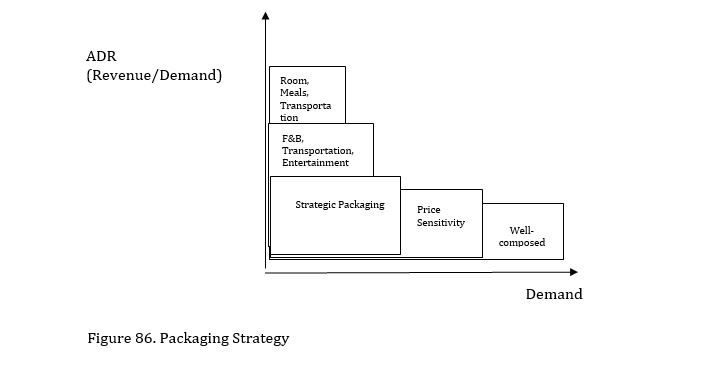
6.3. Packaging process
The packaging process in the hospitality industry involves several key stages that ensure the effective creation and delivery of service or product bundles. These stages include packaging data, packing internal components, and packing external components. Here’s an expanded look at each stage:
6.3.1. Packaging Data
Definition: Packaging data refers to the process of gathering, analyzing, and organizing information related to the components of the bundle and the target market to create a well-defined and attractive package.
Data Collection: Collect data on guest preferences, booking patterns, and spending behavior. This can include market research, guest surveys, and analysis of past booking trends.
Competitor Analysis: Analyze competitors’ offerings to understand their bundling strategies and identify opportunities for differentiation.
Component Evaluation: Assess the potential components to include in the package, such as room types, dining options, spa services, and local attractions. Evaluate their popularity and profitability.
Pricing Analysis: Determine the cost of each component and establish a pricing strategy that offers perceived value while ensuring profitability.
Guest Preferences: Analyze data to determine if guests prefer wellness packages or family-friendly bundles.
Competitor Bundles: Review competitors’ packages to find gaps or opportunities for unique offerings (Figure 87).
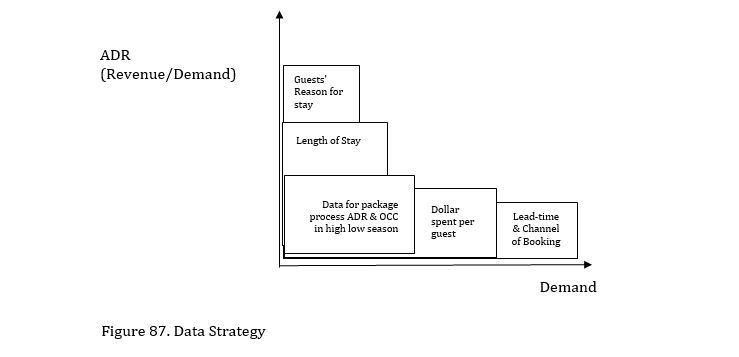
6.3.2. Packing Internal Components
Definition: Packing internal components involves selecting and organizing the core elements of the package that will be included directly within the hotel’s operations and services.
Component Selection: Choose which internal services and amenities will be included in the package, such as room types, dining credits, or spa treatments.
Integration: Ensure that these components are seamlessly integrated into the hotel’s operations. This may involve coordinating with different departments (e.g., front desk, restaurant, spa) to ensure availability and quality.
Internal Coordination: Work with internal teams to ensure that they understand the package details, including any special requirements or promotions related to the bundle. Bundling a restaurant credit or spa service offered by a hotel outlet.
Training: Train staff on how to handle bookings related to the package, upsell additional services, and deliver the package components effectively.
Room Selection: Decide on the room types that will be included in the package and ensure they are available.
Dining Integration: Coordinate with the restaurant to provide meal options and credits included in the package (Figure 88).
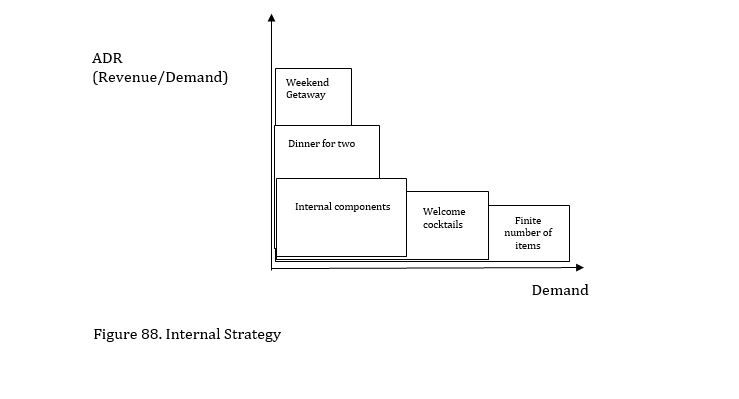
3. Packing External Components
Definition: Packing external components involves incorporating elements that are outside the hotel’s immediate control but are essential to the package, such as partnerships with local attractions, transportation services, or external vendors. Bundling a third party service such a zoo admission tickets.
Partnership Development: Establish partnerships with external vendors or local attractions to include their services in the package. This may involve negotiating terms and ensuring mutual benefits.
Integration: Ensure that external components are effectively integrated into the package and that guests have a seamless experience. This includes coordinating with external partners to manage bookings and provide necessary information.
Coordination: Work with external partners to ensure that they understand the package details and are prepared to fulfill their part of the offering.
Quality Control: Monitor and evaluate the quality of the external components to ensure they meet guest expectations and contribute positively to the package experience.
Local Attractions: Partner with nearby attractions to include tickets or discounts as part of the package.
Transportation Services: Coordinate with transportation providers to offer shuttle services or car rentals as part of the package (Figure 89).
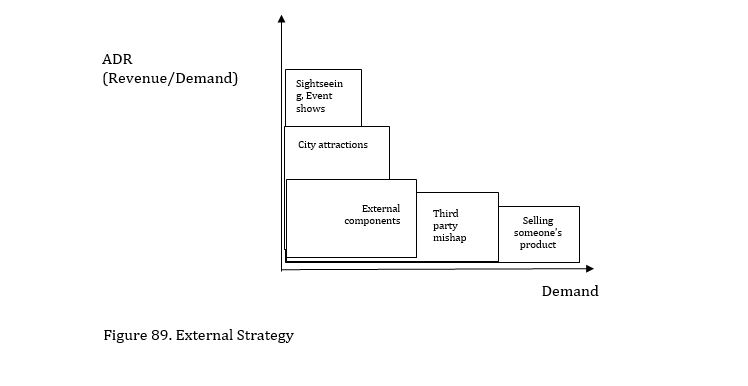
Implementation and Execution
The final stage involves executing the package, promoting it to potential guests, and ensuring that all components are delivered as promised. Develop and implement marketing strategies to promote the package, including digital advertising, social media, and email campaigns. Update reservation systems to include the package and ensure that it is easily bookable online or through other channels. Provide clear information to guests about the package details, including what is included and how to redeem any external components. Ensure that all components of the package are delivered as promised, both internally and externally. Address any issues or special requests promptly to maintain guest satisfaction. Launch a targeted marketing campaign highlighting the benefits and savings of the package. Ensure the package is visible and easily bookable on the hotel’s website and booking platforms.
Assess the performance of the package to determine its effectiveness and make any necessary adjustments to improve future offerings. Monitor key metrics such as booking rates, revenue, and guest feedback to evaluate the package’s success. Gather guest feedback to understand their experience and identify areas for improvement. Make adjustments to the package based on performance data and feedback, such as refining components, altering pricing, or enhancing marketing efforts. Use surveys to collect feedback from guests who booked the package to gain insights into their satisfaction. Review financial reports to assess the impact of the package on overall revenue and profitability.
The packaging process in the hospitality industry involves a series of steps to create, organize, and deliver bundles of services and products that offer added value to guests. By effectively managing packaging data, packing internal and external components, and ensuring successful implementation and evaluation, hotels can enhance guest experiences, drive increased revenue, and differentiate themselves from competitors. Strategic packaging requires careful planning, coordination, and ongoing optimization to maximize its benefits and meet both guest expectations and business goals.
7. Distribution Management
Distribution Management in the hospitality industry involves overseeing and optimizing the various channels through which hotel rates and availability are offered to potential guests. Effective distribution management ensures that the hotel’s offerings reach a broad audience and are accessible through multiple booking platforms, enhancing visibility and increasing bookings. Here’s an expanded look at the three main types of distribution channels:
1. Voice Channel
Definition: The voice channel refers to reservations made through direct communication with the hotel, typically via phone calls. This channel allows for personalized service and direct interaction with potential guests.
Key Aspects:
Direct Reservations: Guests call the hotel directly to inquire about availability, rates, and make reservations.
Customer Service: Providing a high level of customer service is crucial for handling inquiries and bookings effectively. Front desk staff or reservation agents need to be well-trained in upselling and cross-selling.
Flexibility: The voice channel offers flexibility in terms of customizing bookings and accommodating special requests or preferences.
Follow-up: Post-booking follow-up can be done to confirm details, offer additional services, and ensure a positive guest experience.
Examples:
Reservation Call Center: A dedicated phone line for reservations where guests can call to book rooms, inquire about rates, or ask about special packages.
Front Desk Booking: Direct booking through the hotel’s front desk, where staff can offer immediate assistance and personalized service (Figure 90).
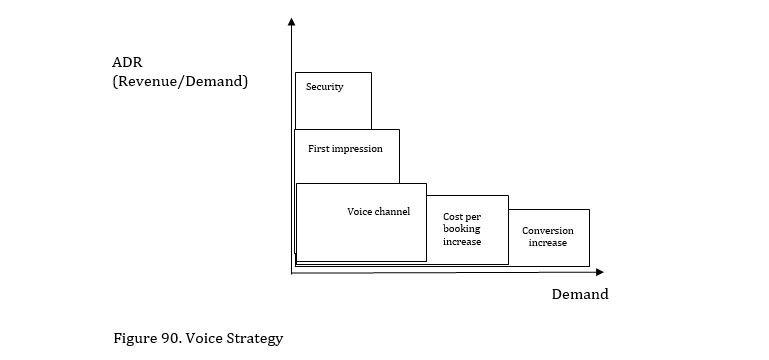
2. Global Distribution System (GDS)
Definition: Global Distribution Systems are computerized networks that facilitate the booking of hotel rooms, flights, car rentals, and other travel services. GDS platforms are primarily used by travel agents and corporate travel managers.
Key Aspects:
Network Reach: GDS platforms connect hotels with a global network of travel agents and corporate clients, expanding market reach.
Integration: Hotels need to integrate their inventory and rates with GDS systems to ensure real-time availability and accurate information.
Booking Efficiency: GDS systems streamline the booking process for travel agents, allowing them to compare rates, availability, and make reservations efficiently.
Corporate and Group Travel: GDS platforms are essential for managing bookings related to corporate travel and large group reservations.
Examples:
Amadeus: A major GDS platform that provides access to hotel inventory, rates, and availability for travel agents and booking systems.
Sabre: Another GDS platform that connects hotels with a network of travel agents and corporate clients worldwide (Figure 91).
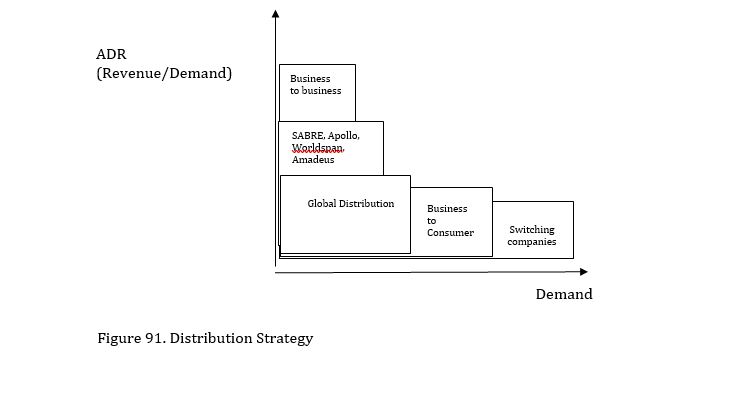
3. Internet Channels
Definition: Internet channels encompass online platforms and tools that enable guests to search for, compare, and book hotel accommodations. These channels include the hotel’s own website, Online Travel Agencies (OTAs), and metasearch engines.
Key Aspects:
Hotel Website: The hotel’s official website should be optimized for booking, providing guests with direct access to rates, availability, and special offers.
Online Travel Agencies (OTAs): Platforms such as Expedia, Booking.com, and Agoda where hotels list their rooms and rates to attract bookings from a broad audience.
Metasearch Engines: Websites like Trivago and Kayak aggregate information from multiple OTAs and hotel websites, allowing users to compare prices and book accommodations.
Digital Marketing: Effective use of SEO, PPC, and social media marketing helps drive traffic to the hotel’s website and increase bookings through online channels.
Examples:
Hotel Booking Website: The hotel’s official booking platform where guests can book directly, view exclusive offers, and receive better rates.
Expedia: An OTA where hotels list their rooms to reach a global audience and attract bookings.
Trivago: A metasearch engine that compares hotel prices from various OTAs and directs users to booking sites (Figure 92).
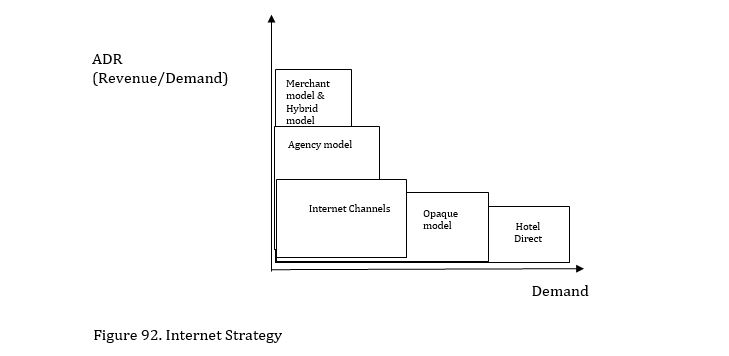
Implementation and Optimization
Definition: Managing and optimizing distribution channels involves ensuring that hotel rates and availability are effectively presented across all chosen channels to maximize bookings and revenue.
Channel Management Software: Utilize software tools to manage and synchronize rates, availability, and reservations across multiple distribution channels. This helps prevent overbooking and ensures accurate information.
Rate Parity: Maintain consistent pricing across all distribution channels to avoid discrepancies and potential conflicts with guests or partners.
Performance Monitoring: Regularly monitor the performance of each distribution channel to assess its effectiveness, identify trends, and make necessary adjustments.
Channel Mix Optimization: Evaluate the performance of different channels and adjust the mix to focus on those that deliver the best results in terms of bookings and revenue.
Channel Manager: A software tool that helps hotels update rates and availability across multiple OTAs and GDS platforms from a single interface.
Performance Analytics: Tools that track booking sources, revenue generated by each channel, and guest preferences to optimize distribution strategies.
Distribution Management is a critical aspect of hotel operations that involves managing various channels through which guests can book accommodations. By effectively utilizing voice channels, global distribution systems, and internet channels, hotels can enhance their visibility, attract a diverse range of guests, and optimize bookings. Successful distribution management requires careful coordination, strategic planning, and ongoing evaluation to ensure that all channels are utilized effectively and contribute to the hotel’s overall revenue and guest satisfaction goals.
8. Transient/Group Strategy
Transient and Group Strategies in the hospitality industry involve different approaches to managing bookings and revenue based on the type of guest—whether they are individual transient guests or part of a group. Here’s an expanded look at these strategies:
1. Transient Strategy
Definition: The transient strategy focuses on managing and optimizing bookings from individual travelers or small groups who typically stay for short periods and book their accommodations independently. These guests are often leisure travelers, business travelers, or those looking for a quick getaway.
Key Components:
1.1. Pricing and Promotions
Dynamic Pricing: Implementing flexible pricing strategies based on demand, booking lead time, and market conditions. Prices may vary depending on the season, day of the week, and special events.
Special Offers and Packages: Creating attractive offers such as last-minute deals, advance purchase rates, or exclusive discounts to encourage bookings from transient guests.
Loyalty Programs: Offering rewards and incentives through loyalty programs to encourage repeat bookings and increase guest retention.
Examples:
Advance Purchase Discounts: Offering lower rates for guests who book their stay several weeks in advance.
Weekend Getaway Packages: Creating special deals for weekend stays that include added perks like free breakfast or room upgrades.
1.2. Marketing and Distribution
Online Channels: Leveraging online travel agencies (OTAs), metasearch engines, and the hotel’s own website to reach transient guests. Ensuring that pricing and availability are accurately represented across all platforms.
Targeted Advertising: Using digital marketing strategies such as pay-per-click (PPC) ads, social media campaigns, and email marketing to target individual travelers based on their interests and booking behavior.
Examples:
Social Media Campaigns: Running targeted ads on platforms like Instagram and Facebook to attract leisure travelers.
Email Marketing: Sending personalized offers and promotions to past guests and potential customers.
1.3. Guest Experience
Personalization: Offering personalized experiences based on guest preferences and past behavior. This can include room preferences, welcome amenities, or tailored recommendations for local attractions.
Streamlined Booking: Ensuring an easy and efficient booking process through the hotel’s website or mobile app. Offering instant confirmation and flexible cancellation policies.
Examples:
Personalized Welcome Amenities: Providing welcome gifts or personalized notes based on guest preferences or previous stays.
Mobile Check-In: Allowing guests to check in and access their room using a mobile app for a seamless experience.
2. Group Strategy
Definition: The group strategy focuses on managing and optimizing bookings for larger groups, such as corporate meetings, conferences, weddings, or tour groups. These guests often require multiple rooms and additional services, and their needs can be more complex.
Key Components:
2.1. Pricing and Contract Negotiations
Group Rates: Offering discounted rates or special packages for groups based on the number of rooms or nights booked. Rates may be negotiated based on group size, seasonality, and length of stay.
Contract Agreements: Creating detailed contracts that outline the terms and conditions of the booking, including rates, payment terms, and cancellation policies.
Examples:
Corporate Group Discounts: Providing special rates and amenities for companies booking multiple rooms for business travel or meetings.
Wedding Packages: Offering comprehensive packages for wedding parties that include accommodations, catering, and event space.
2.2. Planning and Coordination
Dedicated Group Sales Team: Having a dedicated team or coordinator to handle group bookings, manage logistics, and ensure that all needs are met. This includes planning room assignments, meeting space arrangements, and catering requirements.
Customized Services: Providing tailored services such as dedicated check-in desks, group dining options, and transportation arrangements to accommodate the specific needs of the group.
Examples:
Event Planning Assistance: Offering support for planning and organizing group events, including room layouts, audio-visual equipment, and catering.
Transportation Services: Arranging shuttle services or transportation for groups to and from the hotel or event venues.
2.3. Marketing and Sales
Targeted Outreach: Reaching out to potential group clients through direct sales efforts, industry events, and partnerships with event planners or corporate clients.
Showcasing Facilities: Highlighting the hotel’s facilities and services that cater to groups, such as meeting rooms, banquet halls, and conference equipment, through targeted marketing materials and presentations.
Examples:
Corporate Outreach: Contacting companies and organizations directly to offer group rates and services for business events or travel.
Event Planners: Partnering with event planners and wedding coordinators to promote the hotel as a venue for group events.
2.4. Guest Experience
Group Amenities: Offering amenities and services that cater to the needs of groups, such as group dining options, team-building activities, and special requests.
Feedback and Follow-Up: Collecting feedback from group organizers and participants to ensure satisfaction and address any issues. Following up to build relationships for future group bookings.
Examples:
Group Dining: Providing customized dining options or group dining rooms for meals and social events.
Post-Event Surveys: Sending surveys to group organizers to gather feedback on their experience and identify areas for improvement.
Conclusion
Transient and group strategies represent two distinct approaches to managing bookings and revenue in the hospitality industry. The transient strategy focuses on attracting and serving individual travelers or small groups with flexible pricing, targeted marketing, and personalized guest experiences. In contrast, the group strategy involves managing larger bookings with negotiated rates, detailed planning, and customized services to meet the complex needs of corporate clients, event organizers, and other large groups. Both strategies require careful planning, coordination, and execution to maximize revenue and ensure a positive guest experience (Figure 93).
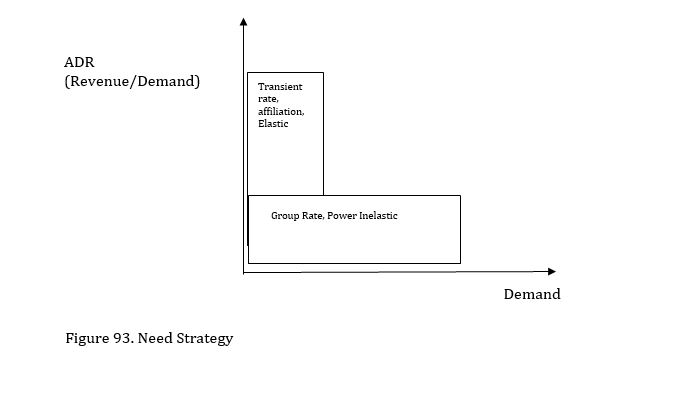
9. New Business booking
New Business Booking involves adjusting rates based on the guest’s relationship with the hotel, frequency of visits, and type of booking. This strategy allows hotels to offer differentiated pricing to attract and retain various types of guests, ranging from occasional visitors to frequent patrons. Here’s an expanded look at the different rate classes and how they impact booking strategies:
1. Rack Rate
Definition: The rack rate is the standard, non-discounted rate set by the hotel. It represents the highest possible rate that guests can be charged without any negotiated discounts or special offers.
Key Aspects:
Standard Rate: The base price that serves as the starting point for all other discounted rates.
Publicly Available: Often displayed on the hotel’s website and booking platforms.
Flexibility: Serves as a reference point for negotiations and comparisons with other rates.
Examples:
Website Rate: The price listed on the hotel’s official website for a standard room without any discounts.
Walk-In Rate: The rate charged to guests who book a room directly at the hotel without prior reservations.
2. Corporate Rate
Definition: Corporate rates are special rates offered to businesses and their employees. These rates are usually negotiated and provide discounts to encourage corporate clients to use the hotel for business travel.
Key Aspects:
Negotiated Discounts: Rates are typically lower than the rack rate and are negotiated between the hotel and the company.
Long-Term Relationships: Designed to build long-term relationships with companies and encourage repeat business.
Booking Flexibility: Often includes flexible booking terms and additional amenities for business travelers.
Examples:
Business Travelers: Employees of a corporation booking rooms as part of their business trips.
Company Contracts: Agreements between the hotel and a company to offer discounted rates for all employees traveling on business.
3. Group Rate
Definition: Group rates are discounted rates offered to groups booking multiple rooms or event spaces at the hotel. These rates are typically lower than the rack rate and are designed to attract larger bookings for events, conferences, or tours.
Key Aspects:
Volume Discounts: Rates are based on the number of rooms or event spaces booked, offering lower prices for larger groups.
Event Coordination: Often includes additional services such as meeting room setups, catering, and group activities.
Booking Requirements: May require a minimum number of rooms or a deposit to secure the group rate.
Examples:
Corporate Retreats: Companies booking a block of rooms for a team-building retreat or conference.
Wedding Parties: Offering special rates for wedding guests booking rooms for an event.
4. Event Rate
Definition: Event rates are special rates offered to guests attending specific events or functions hosted by the hotel or external organizations. These rates are designed to attract attendees to stay at the hotel during events such as weddings, conventions, or concerts.
Key Aspects:
Event-Specific Discounts: Rates are linked to a particular event or function, often requiring guests to mention the event when booking.
Limited Availability: Rates may be offered for a limited time around the event dates.
Enhanced Services: May include additional perks or services related to the event.
Examples:
Conference Attendees: Special rates for guests attending a conference or trade show hosted at the hotel.
Event Guests: Discounts for attendees of a wedding or social event held at the hotel.
5. Hurdle Rate
Definition: The hurdle rate is a special, often lower rate offered to encourage bookings when demand is lower or to meet specific revenue goals. It’s a rate that must be “hurdled” or surpassed by certain criteria, such as booking frequency or advanced purchase.
Key Aspects:
Incentive-Based: Rates are designed to incentivize bookings under specific conditions, such as booking in advance or committing to a non-refundable reservation.
Demand Management: Used to fill rooms during low-demand periods or to reach revenue targets.
Eligibility Criteria: May include conditions such as non-refundable bookings or minimum stay requirements.
Examples:
Advance Purchase Rate: Offering a significantly lower rate for guests who book several months in advance.
Non-Refundable Rate: Lower rates for reservations that require full prepayment and are non-refundable.
Implementation and Optimization
Definition: Effectively managing and optimizing these different rate classes involves understanding guest behavior, market conditions, and strategic pricing.
Key Steps:
Rate Management: Use revenue management systems to track and adjust rates dynamically based on booking patterns and demand.
Guest Segmentation: Analyze guest data to identify and target different segments with appropriate rates.
Promotional Strategies: Develop targeted promotions and offers to attract guests across different rate classes.
Monitoring and Adjusting: Regularly review rate performance and make adjustments as needed to optimize revenue and occupancy.
Examples:
Revenue Management Software: Tools that analyze booking data and adjust rates in real-time based on demand and market trends.
Marketing Campaigns: Tailored promotions for specific guest segments to drive bookings and fill rooms.
Conclusion
New Business Booking involves offering differentiated rates to various types of guests, from those who book directly at the rack rate to those who benefit from corporate, group, event, or hurdle rates. By understanding and implementing these different rate classes, hotels can effectively manage their pricing strategy, attract a diverse range of guests, and optimize revenue. Each rate class serves a specific purpose and targets different guest segments, allowing hotels to maximize their booking potential and enhance overall profitability (Figure 94).
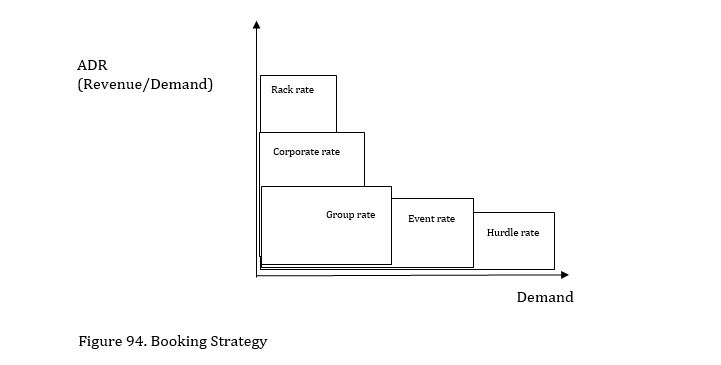
10. Elasticity Strategy
Elasticity Strategy in the hospitality industry involves adjusting room prices based on the price sensitivity of different guest segments and market conditions. This strategy aims to optimize revenue by finding the right balance between raising and lowering prices in response to demand fluctuations and guest behavior. Here’s an expanded look at how elasticity strategy works:
1. Understanding Elasticity
Definition: Elasticity refers to how sensitive a guest is to changes in price. In economic terms, it measures the responsiveness of demand to price changes.
Elastic Demand: When a small change in price leads to a significant change in the quantity demanded. Price-sensitive guests fall into this category.
Inelastic Demand: When changes in price have little effect on the quantity demanded. Price-insensitive guests fall into this category.
Key Concepts:
Price Sensitivity: How likely guests are to change their booking behavior in response to changes in price.
Revenue Optimization: Adjusting prices based on elasticity to maximize overall revenue.
2. Implementing Elasticity Strategy
2.1. Pricing Adjustments Based on Elasticity
Price-Sensitive Guests (Elastic Demand):
Lower Prices: To attract guests who are highly sensitive to price changes. Reducing prices can increase occupancy and drive bookings from guests who would otherwise book elsewhere or not book at all.
Promotions and Discounts: Offering special deals, discounts, or packages to appeal to price-sensitive guests and boost occupancy.
Examples:
Last-Minute Deals: Offering lower rates close to the check-in date to fill unsold rooms.
Flash Sales: Running short-term promotions to attract price-sensitive travelers.
Price-Insensitive Guests (Inelastic Demand):
Higher Prices: Increasing prices for guests who are less sensitive to price changes, thereby maximizing revenue from those willing to pay more.
Premium Offerings: Adding value through enhanced services or amenities to justify higher rates.
Examples:
Luxury Upgrades: Charging a premium for high-end rooms or suites with additional amenities.
Seasonal Rates: Increasing prices during peak seasons or special events when demand is high.
2.2. Channel-Specific Pricing
Distribution Channels:
Direct Booking Channels: Setting different prices on the hotel’s website compared to other channels. For example, offering lower rates or exclusive packages to guests who book directly through the hotel’s website.
Online Travel Agencies (OTAs): Adjusting prices on OTAs based on the competitive landscape and demand. OTAs often attract price-sensitive travelers, so offering competitive rates can help increase visibility and bookings.
Corporate and Group Bookings: Implementing different pricing strategies for corporate clients or large groups based on their booking patterns and price sensitivity.
Examples:
Best Rate Guarantee: Offering a lower price on the hotel’s website compared to OTAs to encourage direct bookings.
Group Discounts: Providing special rates for large group bookings to attract more business.
2.3. Dynamic Pricing
Definition: Dynamic pricing involves continuously adjusting room rates in real-time based on changing demand, booking patterns, and market conditions.
Key Aspects:
Revenue Management Systems: Utilizing software tools to analyze data and adjust prices dynamically. These systems help forecast demand, track competitor pricing, and optimize rates.
Market Trends: Monitoring market trends and booking patterns to make informed pricing decisions.
Examples:
Real-Time Adjustments: Automatically adjusting prices based on real-time data, such as occupancy levels or competitor rates.
Forecasting Models: Using historical data and predictive analytics to anticipate demand and set optimal prices.
2.4. Seasonal and Event-Based Pricing
Definition: Adjusting prices based on seasonal trends and special events that influence demand.
Key Aspects:
Peak Seasons: Increasing prices during high-demand periods, such as holidays, summer vacations, or major local events.
Off-Peak Seasons: Offering lower rates during low-demand periods to attract more bookings.
Examples:
Holiday Pricing: Raising prices during major holidays when demand is typically high.
Event Rates: Offering special rates for guests attending local events or conferences.
3. Evaluating and Adjusting Strategy
Definition: Regularly reviewing and adjusting the elasticity strategy to ensure it remains effective and aligned with market conditions.
Key Steps:
Performance Analysis: Monitoring revenue, occupancy rates, and guest feedback to assess the effectiveness of pricing adjustments.
Competitor Benchmarking: Comparing pricing strategies with competitors to ensure competitive positioning.
Guest Segmentation: Analyzing guest segments to understand their price sensitivity and tailor pricing strategies accordingly.
Examples:
Revenue Reports: Reviewing financial reports to determine the impact of pricing changes on revenue and occupancy.
Competitive Analysis: Analyzing competitor pricing and adjusting strategies to stay competitive in the market.
Conclusion
Elasticity Strategy is a dynamic approach to pricing that involves adjusting rates based on the price sensitivity of different guest segments and market conditions. By understanding and implementing elasticity principles, hotels can optimize their pricing strategies to maximize revenue, attract a diverse range of guests, and effectively manage demand. This strategy requires continuous monitoring, analysis, and adjustment to ensure that pricing remains competitive and aligned with the hotel’s revenue goals (Figure 95).
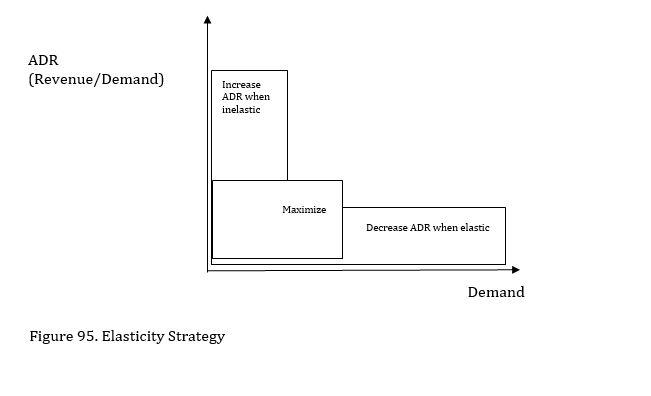
Key Terms
1. Change the Demand
Definition: Modifying or influencing the level of demand for hotel rooms through various strategies and tactics.
Purpose: To increase or manage demand based on market conditions, business objectives, or external factors.
How It Works: Hotels may use promotional campaigns, dynamic pricing, targeted marketing, or special offers to drive higher demand.
Example: Launching a limited-time discount offer to boost bookings during a traditionally slow period or promoting a special package to attract guests during a local event.
2. Change the Equilibrium
Definition: Adjusting the balance between supply and demand to optimize revenue and occupancy. Equilibrium is achieved when the quantity of rooms demanded equals the quantity of rooms supplied at a given price.
Purpose: To ensure that supply and demand are balanced in a way that maximizes revenue and occupancy rates.
How It Works: Hotels can shift equilibrium by adjusting prices, managing inventory, or introducing new offerings to align with changing market conditions.
Example: Increasing room rates during high-demand periods to balance out the supply and demand and maximize revenue.
3. Change the Supply
Definition: Modifying the availability of rooms or services to influence market conditions and revenue.
Purpose: To manage inventory effectively and optimize revenue based on current demand and market trends.
How It Works: Hotels may adjust the number of rooms available for booking, introduce new room types, or manage availability across different distribution channels.
Example: Reducing the number of rooms available for discount rates to ensure higher rates are available for direct bookings or adjusting room availability during peak seasons.
4. Change the Mix
Definition: Adjusting the composition of room types, rates, or services offered to optimize revenue and meet market demand.
Purpose: To cater to different customer segments and maximize revenue by offering a variety of options.
How It Works: Hotels can change the mix by offering different types of rooms, varying rates, or bundling services to appeal to different market segments.
Example: Introducing premium room categories or packages with additional services to attract high-paying guests while maintaining standard rates for budget-conscious travelers.
5. Strategic Pricing
Definition: Setting room rates based on long-term business objectives and market conditions to achieve revenue goals.
Purpose: To align pricing strategies with overall business goals, such as maximizing revenue, maintaining market position, or responding to competition.
How It Works: Strategic pricing involves analyzing market trends, competitive positioning, and customer preferences to set optimal prices.
Example: Implementing a tiered pricing structure where rates increase as the booking date approaches to capitalize on higher willingness to pay among last-minute bookers.
6. Change Revenue
Definition: Adjusting strategies and tactics to alter the total revenue generated from room sales and other hotel services.
Purpose: To increase or optimize revenue based on current market conditions and business objectives.
How It Works: Changes may include adjusting room rates, introducing new revenue streams, or improving upselling and cross-selling efforts.
Example: Implementing upsell strategies for premium room upgrades or additional services like spa treatments to boost overall revenue per guest.
7. Distribution Management
Definition: The process of managing how and where hotel rooms are sold through various distribution channels, such as direct bookings, online travel agencies (OTAs), and global distribution systems (GDS).
Purpose: To optimize the reach and effectiveness of room sales and maximize revenue from different distribution channels.
How It Works: Hotels use distribution management systems to control inventory, set pricing rules, and monitor performance across various channels.
Example: Adjusting room availability and pricing on OTAs and the hotel’s own website to ensure rate parity and maximize bookings from each channel.
8. Transient Group Strategy
Definition: A strategy for managing bookings from transient groups, which are typically smaller, non-contractual groups that book on an individual basis or for short-term stays.
Purpose: To optimize revenue from transient group bookings while managing inventory and pricing effectively.
How It Works: Hotels may use targeted marketing, special offers, or dynamic pricing to attract transient groups and manage their impact on overall inventory.
Example: Offering group discounts for transient groups booking multiple rooms during a specific period or providing special packages to attract short-term group bookings.
9. New Business Booking
Definition: Strategies and tactics focused on acquiring new bookings and attracting new customers to the hotel.
Purpose: To increase revenue by generating new reservations and expanding the customer base.
How It Works: This involves marketing campaigns, promotions, and outreach efforts to attract new guests and secure new bookings.
Example: Running a targeted advertising campaign or special introductory offer to attract new customers and increase bookings during a specific period.
Price Elasticity of Demand
Definition: Price elasticity of demand measures how the quantity demanded of a good responds to a change in price. In the context of hotels, it reflects how sensitive guests are to price changes.
Types:
Elastic Demand: Small changes in price lead to significant changes in demand (e.g., luxury hotels).
Inelastic Demand: Changes in price have little impact on demand (e.g., budget hotels in high-demand areas).
2. Segment Your Market
Leisure vs. Business Travelers: Leisure travelers might be more price-sensitive and respond to discounts or promotions, while business travelers might value convenience and be less sensitive to price changes.
Different Demographics: Tailor pricing strategies for various age groups, income levels, and travel preferences.
3. Dynamic Pricing
Revenue Management: Adjust prices based on demand, booking patterns, and competition. Use algorithms to predict demand and set optimal prices.
Seasonality: Implement higher prices during peak seasons and offer discounts during off-peak periods.
Booking Window: Adjust prices based on how far in advance guests book. Early bookings might have lower rates, while last-minute bookings can be priced higher.
4. Bundle Pricing Strategies
Package Deals: Combine room rates with additional services such as meals, spa treatments, or local attractions to increase perceived value.
Customizable Packages: Allow guests to select from various add-ons, increasing the likelihood of higher spending per booking.
5. Promotions and Discounts
Targeted Offers: Use data analytics to target specific customer segments with tailored promotions.
Loyalty Programs: Offer rewards and discounts to repeat customers, which can increase demand and reduce price sensitivity over time.
Flash Sales: Create urgency with limited-time offers to boost bookings during slow periods.
6. Competitor Analysis
Market Positioning: Understand your competitive landscape. Adjust your pricing based on how your hotel compares to competitors in terms of services, location, and amenities.
Competitive Pricing: Regularly review and adjust your rates based on competitors’ pricing and promotions.
7. Monitor and Adjust
Track Performance: Continuously monitor booking patterns, revenue, and occupancy rates. Use this data to make informed adjustments to your pricing strategy.
Customer Feedback: Gather and analyze guest feedback to understand how pricing affects satisfaction and perception of value.
8. Technology Integration
Revenue Management Systems (RMS): Invest in technology that provides real-time data and predictive analytics to optimize pricing strategies.
Booking Platforms: Use advanced booking platforms that integrate with your RMS to automate and streamline pricing adjustments.
9. Legal and Ethical Considerations
Fair Pricing: Ensure that pricing strategies comply with regulations and maintain transparency with guests.
Avoid Price Gouging: During emergencies or high-demand periods, ensure that prices remain fair and reasonable.
Implementing these strategies requires a deep understanding of your market, effective use of technology, and ongoing analysis of performance data to maximize revenue and ensure guest satisfaction.
Review Questions
- Draw graphs to illustrate (1) Change the demand, (2) change the equilibrium, (3) change the supply, and (4) change the mix.
- Draw graphs to show (1) strategic pricing, (2) change revenue, (3) distribution management, (4) transient group strategy, and (5) new business booking.
- Draw graphs to show the elasticity strategy.

